Introduction to Logistics
Introduction to Logistics by Robert Adzija and Michael Kukhta is licensed under a Creative Commons Attribution-NonCommercial-ShareAlike 4.0 International License, except where otherwise noted.
Conestoga College
Kitchener, Ontario, Canada
Introduction to Logistics by Robert Adzija and Michael Kukhta is licensed under a Creative Commons Attribution-NonCommercial-ShareAlike 4.0 International License, except where otherwise noted.
1
Welcome to Introduction to Logistics, an introductory text focused on moving and storing products in a manufacturing supply chain. We hope it will help you understand what a logistics person, operating domestically or internationally, would need to know to plan, implement and analyze logistics functions and operations. You can investigate the modes of transportation, types of warehouses, costs, services, tradeoffs, and risks that are the significant challenges for all supply chain managers. This book discusses strategies and methods that can add value to a company’s supply chain by improving a logistics network’s productivity, effectiveness, and customer service. This book examines international logistics, vendors, customers, and distribution centers and discusses considerations for comparing the logistics impacts for local and global opportunities.
This OER presents learning materials that reside in the public domain or have been released under licenses or agreements that permit no-cost access, use, adaptation, and redistribution by others.
Students: this OER is different from many traditional textbooks. Interactives, pre-and post-assessments, and other content has been built into each chapter to create a holistic, engaging learning tool. The interactive content serves to reinforce your learning. The pre-and post-assessment activities serve as knowledge checks for your progress.
Faculty and teaching staff: This first version has been created by Michael Kukhta from Conestoga College and Robert Adzija from Fanshawe College to keep this material current by others updating, adapting, and resharing content. This OER will grow as more people contribute to it. We hope that you take this OER and customize it for your program and share it again.
Robert Adzija BA, MBA, P.Log.
Robert is a faculty member in the Lawrence Kinlin School of Business at Fanshawe College in London, Ontario and can be reached at r_adzija@FanshaweC.ca. His career focus has been optimizing logistics networks and improving supply chain visibility. During the 19 years of working in the manufacturing Supply Chain, Robert has led several strategic paradigm shifts. He conceptualized, reorganized, and implemented a new ocean freight strategy, resulting in direct cost savings while improving inventory visibility. Robert has set strategy, negotiated LLP and carrier contracts, and led transition teams. By collaborating with Global Purchasing, Global Logistics and Global Packaging leaders, he has uncovered process blind spots and influenced strategic business process shifts. Robert is passionate about utilizing his industry experience to educate and prepare our future Supply Chain Leaders.
Michael Kukhta, B.Eng. (Mechanical), P.Eng.
Michael Kukhta is a faculty member in the School of Business at Conestoga College, in Kitchener, Ontario and can be reached at mkukhta@conestogac.on.ca. Michael is a fulltime professor on the Supply Chain and Operations Management program team where he helps students develop skills and prepare for the work world. Michael is a Professional Engineer with management and teaching experience in the automotive, aerospace and social services sectors. Michael is a Six Sigma Lean Master Black Belt and has coached and guided many people and organizations to help them improve their performance.
[Automatic Warehouse] by Arno Senoner on Unsplash. Licensed for reuse under the Unsplash License.
2
This project is made possible with funding by the Government of Ontario and through eCampusOntario’s support of the Virtual Learning Strategy. To learn more about the Virtual Learning Strategy visit: https://vls.ecampusontario.ca.


3
We wish to acknowledge Indigenous peoples for their contributions as we work towards reconciliation by learning about the people, the land, and traditional territories on which we work and reside. Conestoga College is located on the traditional territory of the Anishnawbe, Haudenosaunee, and Neutral peoples. Fanshawe College is located on the traditional lands and waterways of the Anishinaabe, Haudenoshaunee, and Lenape people.
We wish to acknowledge and thank the following list of people who supported and participated in this project.
Barbara Kelly PhD, Vice-President of Academic/Student Affairs/Human Resources and Research
Gary Hallam MSc., Vice President, International & Executive Dean School of Business, School of Hospitality & Culinary Art
Michelle Grimes PhD, Dean School of Business
Jeff Fila PhD, Director of Special Projects
James Boesch CPA, CMA, M.Ed., Chair School of Business
Mary Pierce BA MA (ED), Dean, Faculty of Business, Information Technology, Part-time Studies, London South Campus, Acting Associate Dean – Lawrence Kinlin School of Business
Lisa Schwerzmann BA MA, Associate Dean of the Lawrence Kinlin School of Business, Fanshawe College CAAT
Kevin Hollis MBA, BSc, PMP, Conestoga College ITAL for providing a peer review and development of ancillaries.
Holly Ashbourne, Hon. BA, MLIS Conestoga College ITAL, liaison to accessibility and library supports, for providing a final review, and countless support with Pressbooks technology through workshops, diving into Pressbooks to have a look, and answer numerous questions.
Erjona Ferizi, our OER Projects Assistant, who on her co-op from the Bachelor of Public Relations program at Conestoga College ITAL provided ongoing administrative support, coordinated events, and completed extensive first-line copy edits, accessibility checks, labelling multiple images and participating in content creation.
James Yochem, Hon. BA, MLIS Copyright Coordinator, Conestoga College ITAL for answering numerous copyright and copy edit questions.
Kimberlee Carter, BEd., MA, Open Educational Resources (OER) projects consultant, Conestoga College ITAL for spearheading this OER project and keeping us on track.
Antonina Gousseva, BA, Dipl. LIT, Conestoga College ITAL for ensuring this resource met all accessibility requirements.
Juliet Conlon, MLS, Conestoga College ITAL for support in searching out existing OER.
Elan Paulson, PhD, Teaching and Learning Consultant Conestoga College ITAL for providing consultations on design for learning.
We have done our best to acknowledge all participants involved and with correct job titles and credentials. In the event, we have made an error please reach out to any one of the authors to have this corrected.
A supply chain is a network that creates products and services and delivers those products and services to customers. Supply chains include marketing, sales, financing, procurement, processing operations, maintenance, service, and logistics. The focus of this Open Educational Resources (OER) digital textbook is logistics. Logistics refers to the processes and networks used to move and store materials within supply chains and move products to their final destination. Logistics is considered a subset or part of a supply chain.
The coffee sitting on your desk and the food in your home arrived via a product supply chain. The computer you are using to access the information in this OER came via a product supply chain. The digital information you are reading (in the form of electrons and signals) is available for use thanks to an information supply chain. A haircut appointment or a lawyer’s appointment are examples of activities that provide services to you as part of a service supply chain. In this chapter, we will explore the role of logistics in supply chains.
Figure 1.1
Coffee Cup on Desk

Note: From Scott, 2021. CC BY 2.0
An interactive H5P element has been excluded from this version of the text. You can view it online here:
https://ecampusontario.pressbooks.pub/logistics001oerfc/?p=5#h5p-1
Product supply chains start with the demand from a customer for a product. Products begin in the form of raw materials that must be sourced, gathered, converted, and manufactured into the required products. Then, the product is transported to end-users. Products will often stop at warehouses as they move through the product supply chain. There are many steps to convert and transform raw materials into final products that will be delivered to a consumer. Logistics supports the transportation steps in supply chains. Logistics can be categorized as :
Figure 1.2
Note. From Kukhta, 2021. [Image Description]
The information generated by each process in a supply chain supports the supply chain’s logistics networks and operations. This information is itself a supply chain. Consider that similar to products, information is comprised of raw materials such as data and artifacts, that are processed into information such as knowledge, documents like bills of lading, certificates such as health and safety certificates, approvals, and reports. Logistical activity is required to move that information and then store it. In contrast to the physical movement of products, information is moved or transmitted through information systems and electronic data interchange (EDI). Information can be found in reports that need to be distributed in hardcopy, digital, and electronic formats. Storage then takes place in databases, servers, and data warehouses.
Services like haircuts, accounting services or legal advice also have a supply chain. Services unlike products are typically intangible and require supply chain processes that acquire products, knowledge, and develop talent that will be used in the provision of services to customers. Logistics for services depends on producing and supplying products like scissors for barbers, computers for accountants, and cyber-secure information systems to ensure confidentiality of electronic documents for paralegal services.
Whilst downstream logistics refers to the forward movement of raw materials through multiple steps of production, storage, and transportation of final products, upstream logistics refers to the reverse direction movement of products from the customer back through one or more steps of the forward logistics process.
Reverse Supply Chains, therefore, refer to the backward flow of products from downstream to upstream in a supply chain. This process may occur if an item is returned to the manufacturer due to damage, for example, reverse logistics would move these products back to their point of origin or another destination, such as a repair center, upstream in the process.
Circular Supply Chains are a development from the traditional linear product supply chain. They start with raw materials, convert them to products, and then back to the raw materials from whence they started. These types of supply chains emphasize reusing waste materials and returned or old products. Sustainability, social, and economic responsibility are integral to circular supply chains.
Logistics in supply chains considers the total system cost in planning and managing the transportation and storage of products. Starting from the extraction point of the raw materials back to the re-entry of these same raw materials after their initial product life has expired, back into the beginning of a new supply chain in the next life cycle they will experience.
Figure 1.3 shows a simple linear supply chain. In the supply chain, Tier 2 represents raw materials suppliers. Tier 1 represents the sub-assembly parts made from those raw materials. They are then manufactured into products and distributed to retailers where customers, the end-consumer or user, acquire them. This progression represents the forward flow of materials/goods. Other “flows” include the flow of information that runs up and downstream, the flow of money which runs from downstream to upstream, and the reverse flow of materials when a product is returned to the manufacturer (for example, if a product is damaged). Logistics, represented by the blue arrows that connect each tier and each step in the supply chain, are required to manage all of the flows and movement in a supply chain.
Figure 1.3
Upstream and Downstream of a Supply Chain and its Flows
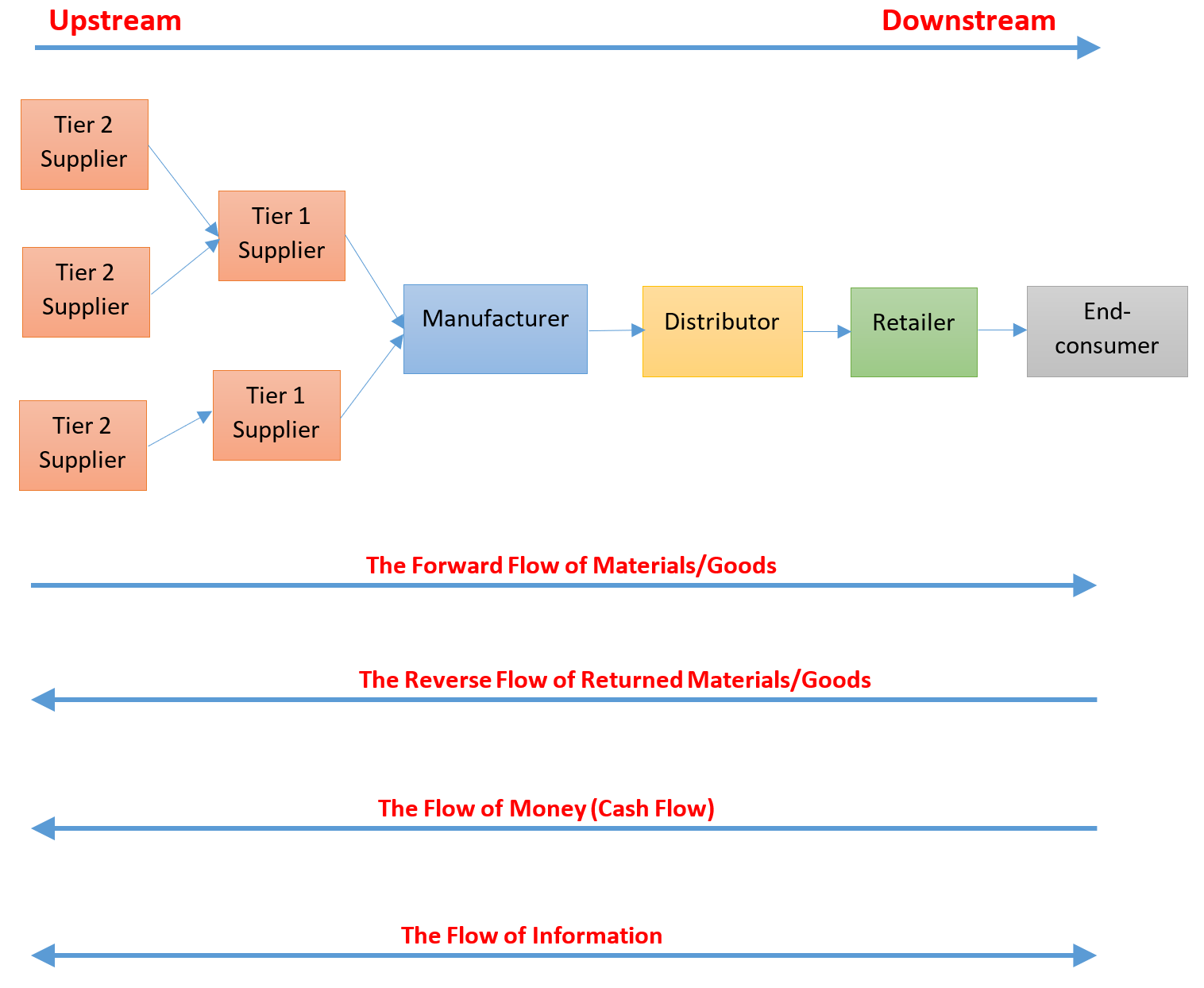
Note: From Faramarzi, H., & Drane, M. CC-BY-NC-SA 4.0 [Figure Description]
The following is a list of common variations to a linear supply chain:
This video demonstrates a product supply chain for bottled water. The logistics component of this supply chain is made up of the trucks that transport the bottled water and the forklifts that load and unload the inventory. Consider the cost of a bottle of water, typically $1.50 or $2.00. How much of that cost goes toward the water, processing, packaging, and the cost of logistics that is spent moving and storing the bottle of water?
W.P. Carey School of Business. (2010, April 6). Module 1: What is supply chain management? (ASU-WPC-SCM) – ASU’s W. P. Carey School [Video]. YouTube. https://youtu.be/Mi1QBxVjZAw
Supply Chain Management is often abbreviated as SCM. Supply chain management is the management of goods and services from the initial idea to the end-users and back to their origin. Supply Chain Management includes procurement (or purchasing) demand planning, sales and operations planning (S&OP), execution and management of supply chain activities, strategic sourcing, transportation management, warehouse management and inventory management. According to APICS Dictionary, 13th edition, it involves the design, planning, execution, control, and monitoring of all supply chain activities. SCM includes:
This video offers definitions and explains the role of managing logistics in a supply chain.
Aims Education, UK. (2016, July 21). What is logistics management? Definition & importance in supply chain [Video]. YouTube. https://youtu.be/4-QU7WiVxh8
Materials and products also need to be moved and stored when they are inside a manufacturer’s facility, inside a distribution centre and when you bring them home. This OER will focus on the logistics between Suppliers and Manufacturers, between Manufacturers and Distribution Centres, between Distribution Centres and Retail stores and between Distribution Centres and Customers, in other words, beforeand afterthe manufacturing/assembly process.
Logistics occur at every step and help the product move through the supply chain from origin to end-user. This is known as Forward Logistics which means product moving forward or downstream from the point of origin (e.g. supplier, manufacturer) to point of consumption (e.g. end-user, customer), or expressed differently, from raw materials to the final product destination. Forward logistics can take place between:
Product moving backward or upstream from the customer back to the supplier or manufacturer is called reverse logistics.
Reasons for using reverse logistics:
Figure 1.4
Nespresso Expands Aluminum Recycling and Reuse

Note. From Nestlé, 2008. CC BY-NC-ND 2.0
“Reverse logistics has been a part of retailing for over 100 years when retailers like Sears Roebuck and Montgomery Ward began delivering goods by railroad. In the past few years, e-commerce has led to an explosion of reverse logistics — or, shipping goods from the consumer back to the retailer. Consumers have come to expect no-fuss return policies; that’s why returns on e-commerce orders are three to four times higher than brick and mortar purchases, according to the Reverse Logistics Association. That means reverse logistics is a fact of life for most companies.” (Syverson, 2021, paras. 1-2).
“Reverse logistics are a very important part of a circular supply chain that finds new uses and/or ensures proper disposal of products that are at the end of their life cycle. Recycling bottles, plastics, batteries and other materials are part of the reverse supply chain.” (Guest Blogger, 2017). Reverse Logistics 101 discusses several successful examples of manufacturers like Apple, H&M, and Dasani using reverse logistics in their processes.
Managing inventory is one of the most important activities in a supply chain. Materials/goods are needed to provide manufacturers with the exact items they need, in the right order, the right quality delivered to the right location, and at the right time. Without all of this happening, it will be impossible to produce high-quality goods and meet commitments to our customers. In addition, when goods are ready for shipment, the outbound supply chain needs to be organized in such a way that customers receive their requested orders in a cost-efficient manner.” (Faramarzi & Drane, n.d., Chapter 7)
This section was adapted from Chapter 7: Supply Chain Management from Introduction to Operations Management by Hamid Faramarzi and Mary Drane, Seneca College, licensed for reuse under CC BY-NC-SA.
Many reasons exist for keeping stocks of inventory. Some of the most common include:
Inventory that is moved and stored in the logistics network can be of any of the types listed above. The cost of inventory and logistics increases as you move downstream through the supply chain. Finished goods are more expensive than other types of inventory because they acquire value through the manufacturing process and the supply chain.
This section was adapted from Chapter 7: Supply Chain Management from Introduction to Operations Management by Hamid Faramarzi and Mary Drane, Seneca College, licensed for reuse under CC BY-NC-SA.
Is there an end to logistics? Is the life cycle of a product linear or straightforward; a product starts with an idea or a need, then is finished when the product is no longer needed or can no longer perform its intended purpose? So what happens to the product at this point? It might just sit around. Do you have a drawer full of old electronics products?
Figure 1.7 shows a drawer open with an old hard drive, a Blackberry, an iPhone 3, and various memory storage devices. In a linear economy, they would just be thrown out into landfills. Could obsolete products be repurposed? I re-purposed my old iPhone 3 as an iPod that I hooked up to my stereo to listen to saved songs and streamed content from the internet for a long time.
Figure 1.5
Obsolete Electronics in a Drawer
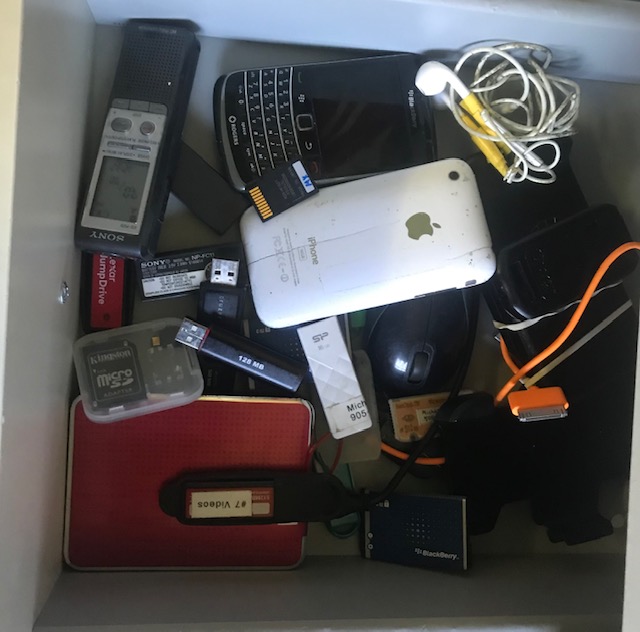
Note. From Kukhta, 2021
In a circular economy, obsolete products such as those shown in Figure 1.7 might be repurposed, reused, or recycled for parts. They might be broken down into their sub-components or raw materials so they can re-enter the supply chain in a new form. In a circular economy, the initial design of products, supply chain, and logistics need to be planned and managed differently. They need to take into account reverse logistics for the successful continuation of the product’s life cycle.
A good question to consider is what happens to materials and products on a supply chain after consumers are done with them? Look around you and ask yourself what will happen to your clothes, products you are using, or the leftovers from services with which you engage? There are many ways to make products and services. There are a wide variety of materials and processes used to make them. Products and services are made using energy from many different sources – both renewable and from sources that produce much pollution.
This image shows a linear economy with a straight line from raw materials to landfills; a reuse economy showing new use of materials, and a circular economy cycle that re-uses materials.
Linear, Reuse, and Circular Economies


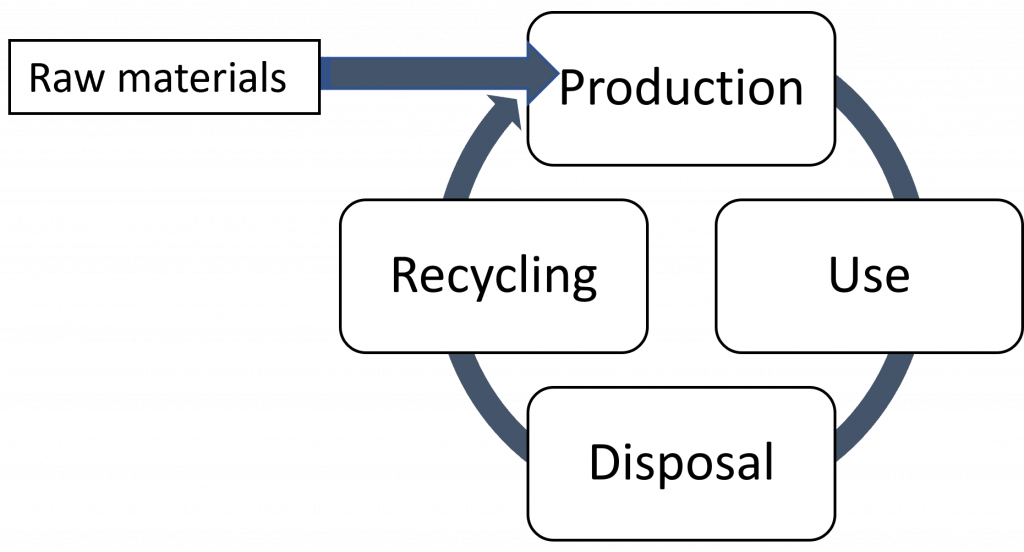
Note. From Kukhta, 2021 [Image Description]
A linear economy, shown at the top of Figure 1.8, follows a traditional “take-make-dispose” plan. This type of economy involves collecting raw materials and transforming them into products that will be used until they are discarded as waste. In the linear economic system, value is created by producing and selling as many products as possible.
The linear economy often ignores the costs of waste generated during manufacturing and costs incurred after the useful product life has ended. The total system costs, including processing, disposal, and logistics (handling and storage) are considered.
An example of linear supply chains and unaccounted for costs of disposal and cleanup are discussed in an article in The Narwhal about Canada’s oilsands and old oil wells:
“Ottawa is paying to clean up Alberta’s inactive wells. Are the oilsands next? As $1 billion in federal funds go to clean up inactive wells, experts are sounding alarm bells about the ‘super experimental’ realm of tailings ponds reclamation and what could be more than $100 billion in unfunded liabilities in the oilsands” (Riley, 2020, para. 1).
A reuse or recycling economy, shown in the middle of Figure 1.8, includes collecting raw materials and transforming them into products. It is similar to a linear economy model. However, unlike the linear economic model, some of those product materials can be put back into the value stream and reused to manufacture new products or distribute more products. In contrast, other products are disposed of as waste. The design, planning, and managing of logistics must consider the recycling process steps, transportation modes, storage, and costs in this type of economy.
An example of this is the Blue Box program for collecting recyclable materials in Ontario, Canada. This article by Stewardship Ontario discusses how costs for processing recycled materials are going up, yet revenues from them are decreasing.
The circular economy, shown at the bottom of Figure 1.8, is an alternative to Canada’s dominant linear economic model. It is grounded in the study of living systems and nature itself. We are pretty used to collecting and transforming resources that are later consumed and become waste once their lifespan ends.
If you look at nature, you can see that processes are different. A tree is born from a seed, it grows and reproduces, and when it dies, it goes back to the soil, enriching it and providing nourishment for new life. How could we apply that process to the objects we use at home and work?
The circular economy looks at all the options across the supply chain to use as few resources as possible. It seeks to keep resources in circulation for as long as possible, extract the maximum value from them while in use, and recover and regenerate products at the end of their service life. The circular economy tries not to view garbage as waste but as a potential resource to be reused. This new way of understanding goods also means designing products using materials that can be easily dismantled and recycled when their initial life cycle is done.
In a circular economy, one considers the impact of materials, resources, and energy used to make products, move them and store them. The goal is to maintain their value for as long as possible, including returning them back into the manufacturing cycle.
The Government of Ontario is changing supply chain rules by shifting responsibility for recycling products at their end of life to their producers. This change will impact where costs are assigned in the logistics networks: “the price of packaged goods expected to go up as costs of recycling shift entirely to producers” (Dunn, 2020, para. 1).
The following organizations are led by experts and interested members who work in supply chains. They conduct research, share knowledge, advocate, train, and provide platforms for learning and discussing what is happening in the industry. They often have student chapters.
The Council of Supply Chain Management Professionals (CSCMP) is an organization based in the United States that helps people working in the supply chain field connect, network, understand and develop supply chain networks. Professional organizations like this have current and relevant information about supply chains and logistics within supply chains.
CSCMP defines logistics management as “that part of supply chain management that plans, implements, and controls the efficient, effective forward and reverses flow and storage of goods, services and related information between the point of origin and the point of consumption in order to meet customers’ requirements.” (Council of Supply Chain Management Professionals, n.d., para. 5).
CSCMP further defines the boundaries and relationships that logistics management has in relation to the rest of the supply chain:
“Logistics management activities typically include inbound and outbound transportation management, fleet management, warehousing, materials handling, order fulfillment, logistics network design, inventory management, supply/demand planning, and management of third-party logistics services providers. To varying degrees, the logistics function also includes sourcing and procurement, production planning and scheduling, packaging and assembly, and customer service. It is involved in all levels of planning and execution–strategic, operational, and tactical. Logistics management is an integrating function, which coordinates and optimizes all logistics activities, as well as integrates logistics activities with other functions including marketing, sales manufacturing, finance, and information technology.” (Council of Supply Chain Management Professionals, n.d., para. 7).
Supply Chain Canada (SCC) is a Canadian organization that is similar to CSCMP. SCC’s vision is “to ensure Canadian supply chain professionals and organizations are recognized for leading innovation, global competitiveness, and driving economic growth” (Supply Chain Canada, 2021, para. 1). Its mission is to “provide leadership to the Canadian supply chain community, provide value to all members, and advance the profession” (Supply Chain Canada, 2021, para. 2).
The Association for Supply Chain Management (ASCM) is “the global leader in supply chain organizational transformation, innovation, and leadership. As the largest non-profit association for supply chains, ASCM is an unbiased partner, connecting companies around the world to the newest thought leadership on all aspects of the supply chain.” (6). ASCM has many resources for supply chain professionals. ASCM has certificate training programs on supply chain subjects, including a Warehousing Certification program.
Joining and participating in activities with professional organizations like these are valuable for networking, learning, and staying current with the activities and practices in supply chains.
An interactive H5P element has been excluded from this version of the text. You can view it online here:
https://ecampusontario.pressbooks.pub/logistics001oerfc/?p=5#h5p-2
“While in Tokyo, Japan, I noticed that there were two sizes for cans of Coca-Cola in a vending machine – 10 fluid oz. (approx. 296 ml) and 12 fluid oz. (approx. 355 ml). However, both were the same price. I asked a Japanese friend why this was the case. Wouldn’t everyone just pick the bigger one, as I did, for the same price? He said that he usually bought the 10 oz. can because that was all he wanted to drink. He did not need the other two oz., so why buy it and waste it? The message is that the Coca-Cola supply chain satisfied the demand for two different customers, but the cost of the extra 2 oz. of Coke was insignificant to the cost of the logistics of supplying the product, leading to the same end cost.” (Kukhta, 2021)
In this chapter, we have explained the role of logistics in supply chains. Logistics supports the transportation of raw materials and products between locations or facilities as they move along the supply chain ending their initial life with the consumer. The circular economy follows a product through its next phases where it is discarded or moves back into the supply chain. We have considered elements such as defective products and inventory that make up a logistics network, examined the importance of logistics to the economy, and provided a review of a supply chain professional organizations and associations.
Association for Supply Chain Management. (2021). Contact us. ASCM. https://www.ascm.org/contact-ascm/
Council of Supply Chain Management Professionals. (2021). CSCMP supply chain management definitions and glossary. CSCMP. https://cscmp.org/CSCMP/Academia/SCM_Definitions_and_Glossary_of_Terms/CSCMP/Educate/SCM_Definitions_and_Glossary_of_Terms.aspx?hkey=60879588-f65f-4ab5-8c4b-6878815ef921
Dunn, T. (202, October 20). Ontario’s new blue box plan will recycle more, but it’ll cost you more as well, experts say. CBC. https://www.cbc.ca/news/canada/toronto/ontario-s-new-blue-box-plan-will-recycle-more-but-it-ll-cost-you-more-as-well-experts-say-1.5768577
Faramarzi, H., & Drane, M. (n.d.) Introduction to operations management. Seneca College Pressbooks Network. https://pressbooks.senecacollege.ca/operationsmanagementintro/. Licensed for reuse under CC BY-NC-SA.
Faramarzi, H., & Drane, M. (n.d.) Upstream and downstream of a supply chain and its flow [Image]. Seneca College Pressbooks Network. https://pressbooks.senecacollege.ca/operationsmanagementintro/chapter/supply-chain/ Licensed for reuse under CC BY-NC-SA.
Guest Blogger. (2017, July 10). Reverse logistics 101. All Things Supply Chain. https://www.allthingssupplychain.com/reverse-logistics-101/
Nestlé. (2008, May 8). Nespresso expands aluminum recycling and reuse [Photograph]. Flickr. https://www.flickr.com/photos/nestle/16354467964. Licensed for reuse under CC BY-NC-ND 2.0.
Riley, S.J. (2020, June 5) Ottawa is paying to clean up Alberta’s inactive wells. Are the oilsands next? The Narwhal. https://thenarwhal.ca/ottawa-paying-clean-up-albertas-inactive-wells-oilsands-next/
Scott, C. (Photographer). (2006, September 8). Coffee cup on desk [Photograph]. Flickr. https://www.flickr.com/photos/callumscott2/265229417/in/photolist-prnsZ. Licensed for reuse CC BY-NC 2.0
Supply Chain Canada. (2021). Who we are. SSC. https://www.supplychaincanada.com/about/who-we-are
Syverson, S. (2021, October 7). 45 Things you should know about reverse logistics. Warehouse Anywhere. https://www.warehouseanywhere.com/resources/45-things-about-reverse-logistics/
Figure 1.2 This figure shows a generic product supply chain flowchart: Raw materials selection then logistics (movement and storage, warehouses and bulk storage), then manufacture stage, then logistics (movement and storage, distribution centres and warehouses), to retail stores and/or consumers, then to product end use. [Back to Image]
Figure 1.3: This figure illustrates the upstream and downstream of a supply chain and its flows. In this chain, Tier 2 represents raw materials suppliers. Tier 1 represents the parts of the product made from those raw materials. They are then manufactured into products and distributed to retailers where customers, the end-consumer or users acquire them. This progression represents the forward flow of materials and/or goods indicated in Figure 1.3. Other “flows” include the flow of information that runs up and downstream, the flow of money which runs from downstream to upstream, and the reverse flow of materials when a product is returned to the manufacturer (E.g., if a product is damaged). Logistics, represented by the blue arrows that connect each tier and each step in the supply chain are required to manage all flows and movement in a supply chain. [Back to Image]
Figure 1.6: The first figure shows a linear economy following a traditional “take make- dispose” plan. Starting from the left to the right, there are Raw materials; Production; Use by the consumer; Disposable; Waste Pollution. This type of economy involves collecting raw materials and making them into products that will be used until they are discarded as waste. The second figure is reuse Economy is a reuse or recycling economy which includes collecting raw materials and transforming them into products. This economy is like a linear economy, the only difference is that some materials can be put back into the value stream and reused to manufacture new products or distribute more products.The third figure is Circular Economy which shows an alternative to Canada’s dominant linear economic model. From raw materials; Production; Use; Disposable to recycling. The circular economy looks at all options across the supply chain to use as few resources as possible and tries not to view garbage as waste but instead as a potential resource to be reused. [Back to Image]
Believe it or not, the typewriter was being used to prepare what we refer to today as a bill of lading 150 years ago. Technology evolved from the 1800s when the telegraph transmitted Morse code. Next came the telephone, then the radio. In 1950 computers entered the scene, and the internet surfaced in the 1990s. Today the Internet of Things, blockchain, GPS tracking, and the electronic transmission of data provide advanced technological advantages to the logistics industry. This chapter explores how technology is being used to improve logistics processes.
Tech Vision. (2020). Inside Amazon’s Smart Warehouse [Video]. YouTube. https://www.youtube.com/watch?v=IMPbKVb8y8s.
An interactive H5P element has been excluded from this version of the text. You can view it online here:
https://ecampusontario.pressbooks.pub/logistics001oerfc/?p=22#h5p-4
The pandemic has highlighted the need for a robust supply chain, and one of the integral elements of an efficiently functioning supply network is the logistics link. In 2021, part shortages, backlogged ocean freight, closed borders, and driver shortages emphasized the importance of logistics in supply chain networks operating effectively. The logistics market in North America is estimated to expand to more than $12 trillion by 2023. (Bohdan, 2021) Logistics operators are looking to technology to gain operational advantages to meet the market demand. According to the Supply and Demand Chain Executive (Bodhan, 2021), six technological trends are leading the way in the transportation industry:
Although we will not be exploring all of the recent evolving technological trends, it is crucial to understand that technology adoption in the transportation industry is a dynamic process requiring agile management practices. When looking to technology for an operational advantage, we look to two areas of application: hardware applications and software applications.
Technology generally falls into one or more categories in the logistics world, as outlined in the table below.
| System Type | Description | Logistics Example |
|---|---|---|
| Office Automation | Helps to process business data, perform calculations and documents. | Spreadsheets, route planning software
|
| Communication | Provides supply chain visibility, freight visibility, facilitates sharing of information. | Virtual meetings, GPS, voice to text technology |
| Transaction Processing | Records BOL, stores transaction information. | EDI, Bar Codes, POS
|
| Management Information | Business analytics, Provides management info in real-time. | Logistics Information Systems |
| Decision Support | Software that enables simulation modes and analysis tools. | WMS, Data mining
|
| Enterprise | Creates and maintains data processing and integrates databases. | ERP systems |
The ultimate goal of technology in the Logistics Information Structure (LIS) is to provide real-time information to management. The LIS collects, analyzes, stores, retrieves, and disseminates data. It provides regular and customized reports. The sole purpose of all this data is to enable data-based decision-making. When failures occur in the supply chain, the first step is to find a solution to keep the freight moving. Once that is completed, root cause analysis routinely follows. One type of technology assisting in the root-cause analysis arena is blockchain technology.
The rise of blockchain technology provides solutions for dispute resolution, order tracking, and administrative efficiency.
“Blockchain technology is based on the concept of a distributed ledger. Instead of a centralized authority, power is distributed across participants on a network” (Shoukry, 2020).
According to Majaski (2021), a distributed ledger can be described as a ledger (collection of accounts or other financial information) of any transactions or contracts maintained in a decentralized form. It is a synchronized database accessible across different locations by a multitude of participants. This type of decentralized information is less prone to cyber attack, fraud, and other manipulation since there is no single point or central authority required. A distributed ledger is a record-keeping of everything that happens in a transaction, and it is stored in sequential order. The information is recorded as it happens and is stored by many participants. Since the ledger storage is decentralized, changing it is nearly impossible.
There are six steps in a typical blockchain transaction (PricewaterhouseCoopers, 2020):
Blockchain technology provides excellent opportunities for supply chains and logistics. Blockchain technology improves the traceability and visibility of freight along the supply chain. Processes can be automated, and any issues or bottlenecks can be seen, allowing participants to resolve the issue immediately (Ceulemans et al., 2020).
Blockchain operates within a network, and no one server holds the data. Instead, all the participants in the network each hold the data. This methodology empowers all network participants and prevents data from being altered. The data remains secure because it exists on many servers, not at a single point. This, in turn, improves data integrity and security. Blockchain is not yet universally adopted in the logistics community, but networks are being developed, and the interest in blockchain is gaining momentum.
Simplilearn. (2019, February 27). Blockchain in 7 minutes [Video]. YouTube. https://www.youtube.com/watch?v=yubzJw0uiE4&t=2s.
Learn more about the potential impacts blockchain can have on logistics and the supply chain in this report from PricewaterhouseCoopers.
GPS technology allows fleet managers to track trucks, trailers, and drivers. Through Global Positioning Systems (GPS), companies can harvest real-time data and improve their supply chain visibility. However, GPS used in isolation limits a fleet manager. Companies need a complete Transportation Management System (TMS) to enable the use of GPS as an input into the logistics of the TMS. TMSs refer to the “category of software that deals with the planning and execution of the physical movement of goods across the supply chain” (Gartner, 2022). These systems focus on aspects of shipping like freight management, carrier rating, and route, mode, and carrier optimization (Essex and Kakade, n.d.).
Telematics is an interface that utilizes GPS, ELD- Electronic Logging Devices, IoT- Internet of Things, to integrate the data and aid in real-time supply chain monitoring. Through a telematics system, fleet managers can re-route drivers based on changing traffic trends, avoid accidents, monitor a driver’s attentiveness, find equipment, and be integral in routing autonomous vehicles.
The supply chain is only as efficient as the data driving it. With the development of new real-time supply chain data sources such as telematics, combined with an interpretative platform, supply chain managers are proactive and more responsive.
ELD is a technology that is significantly impacting the trucking world. A driver’s logbook was updated manually by the driver in the past. The driver would record all on-service hours, driving hours, rest hours, and waiting hours. The logbook is a required document used by Ministry of Transportation officials to validate driver compliance with legislated service hours. Most highway drivers are compensated based on miles driven, not hours of service, so it was not uncommon for drivers to manipulate their logbooks. If the driver could change a couple of entries to enable them to log more miles, they often would. The introduction of electronic logging devices has limited the ability of a driver to manipulate their hours of service. ELDs are becoming a federal requirement in many jurisdictions and driving compliance within the industry.
One element of the supply chain that can improve the utilization and efficiency of logistics is warehouse management. Effective warehouse management allows the logistics arm of the supply chain to function optimally.
Electronic Data Interchange (EDI) is the computer-to-computer exchange of business documents, such as purchase orders and invoices, in a standard electronic format between business partners, such as retailers and their suppliers, banks and their corporate clients, or car-makers and their parts suppliers.
EDI enables the companies to transfer the documents without having any people involved. The documents are automatically transferred from one computer (account) to another. As a result, there are many advantages to using EDI. The primary benefit is the speed and accuracy of the information transmitted. Information is made available in real-time and errors that may have previously been caused during the data entry process are eliminated.
Common information exchanged using EDI include:
Barcodes have been used extensively since the 1970s, and consist of data that is displayed in a machine-readable form that can be scanned by barcode readers. The information contained on the barcode is typically pricing information, product number and description and any other pertinent information. Barcodes have become the norm in retail operations allowing for pricing accuracy and easy price changes. This data provides point-of-sale information to allow retailers to track items being sold, update inventory, identify fast and slow-moving products and assist in forecasting.
Quick Response (known as QR) is using bar codes and EDI to make sales data available to vendors so that vendors can quickly replenish goods in the correct quantity. This is thought of as JIT in the retail industry. The goal is to reduce out-of-stock incidents, as well as use smaller more frequent deliveries to reduce inventory and operating expenses.
This technology uses radio waves to communicate the information contained on a tag attached to an object. The information contained on a tag may include things such as the product’s origin, date of production, shipment information, pricing info, and any other pertinent info. To transfer this info, both a tag and a reader are needed. There are two types of tags, active and passive. An active tag contains a power source such as a battery and can operate a great distance from the reader. Passive tags use energy from the reader. Unlike barcodes, the RFID tag and reader do not require a line of sight to transmit the information.
RFID applications include the following plus many more:
The complexity of the supply chain is rapidly increasing, and understanding how to integrate technology into logistics is crucial. The key takeaway from this chapter is the notion that a supply chain expert must stay abreast of current technology. More importantly, they must understand how to utilize the technology, put it to work; how to harness it.
An interactive H5P element has been excluded from this version of the text. You can view it online here:
https://ecampusontario.pressbooks.pub/logistics001oerfc/?p=22#h5p-3
Bohdan, A. (2021, March 31). Top 6 global logistic technology trends in 2021. Supply and Demand Chain Executive. https://www.sdcexec.com/transportation/article/21307643/amconsoft-top-6-global-logistic-technology-trends-in-2021.
Ceulemans, R., Diefenbach, T., & Guthmann, M. (2020). Blockchain in logistics. PwC. https://www.google.com/url?sa=t&rct=j&q=&esrc=s&source=web&cd=&cad=rja&uact=8&ved=2ahUKEwittIjWhpb1AhUKXc0KHaX5BlAQFnoECAgQAQ&url=https%3A%2F%2Fwww.pwc.de%2Fde%2Fstrategie-organisation-prozesse-systeme%2Fblockchain-in-logistics.pdf&usg=AOvVaw2Wxnaf4X0-EWQfEj55BQuR [opens a PDF]
Essex, D., & Kakade, S. (n.d). Transportation management system (TMS). Tech Target. https://searcherp.techtarget.com/definition/transportation-management-system-TMS
Majaski, C. (2021, October 9). Financial technology and automated investing: Distributed ledgers. Investopedia. https://www.investopedia.com/terms/d/distributed-ledgers.asp
Section 2.9 was adapted from Chapter 7: Supply Chain Management from Introduction to Operations Management by Hamid Faramarzi and Mary Drane. Licensed for reuse under CC BY-NC-SA 4.0)
Strong competition in the open transportation market has driven down profit margins. Even though the profit margin per move in logistics transportation is often slim, the volume of opportunities is great. This combination of low margin and high volume can maximize profits. In a low-margin environment, understanding and controlling costs is imperative.
An interactive H5P element has been excluded from this version of the text. You can view it online here:
https://ecampusontario.pressbooks.pub/logistics001oerfc/?p=52#h5p-5
Logistics cost is simply the total cost of moving freight from one location to another. The definition does not need to be complicated. However, depending on the mode of transportation, the Incoterms, headhaul and backhaul opportunities, figuring out how to allocate and control costs can be confusing. When purchasing logistics services either directly or through a third party, determining the purchase price results from both market supply and demand. As a logistics professional, the ability to maximize profits is determined by finding the balance between cost from a service provider’s perspective and price from the service purchaser’s perspective.
Depending on the mode of transportation, a logistics service provider (LSP) could be a trucking company, a shipping line, a railway, or an airline. This chapter will focus on trucking, also known as over-the-road transportation (OTR). Trucking, like all LSPs, has both fixed and variable costs. A key characteristic of the OTR industry is high variable costs and low fixed costs. The fact that roadways are funded through public revenues contributes significantly to the low fixed costs of the OTR industry. Approximately seventy percent of all costs in the OTR industry are variable costs and attributable to operational costs. (Atri & Murray, 2021)
Fixed costs in trucking are those expenses that will need to be paid regardless of whether or not the operation is hauling any freight. Examples of fixed and variable costs associated with trucking are listed in Table 3.1.
| Fixed | Variable |
|---|---|
| Equipment Lease costs (trucks, trailers,) | Labour (drivers) |
| Depreciation | Fuel |
| Office Leases or rent | Maintenance -parts and labour |
| Garage Leases or rent and/or Property tax | Roadway tolls |
| Interest on vehicles | Insurance, |
| Management costs (salaries) | LIcense, Registrations |
Fuel Surcharge
The cost of fuel is a significant variable cost for any OTR operation. In order to safeguard a motor carrier from operational losses caused by rising fuel costs, the industry has developed a Fuel Surcharge (FSC) formula to offset rising fuel costs. The premise behind the FSC is to pass along increasing fuel costs to the shipper. FSC is based on a peg rate and a national average of fuel costs per month. The difference between the peg rate and the national average diesel price is paid to the OTR carrier as an FSC. The FSC is added to the price of the freight move.
The Service Purchaser’s Perspective
A purchaser of logistics services is a company requiring freight to be transported from one location to another. Understanding the market rate for a move is imperative to operate an efficient supply chain. As a transportation service purchaser, the ideal outcome is to have goods delivered at the right time to the right location at the right price. Market factors such as supply and demand impact the price charged by OTR carriers. Truck driver supply dramatically affects the availability and price of OTR services. A buyer of logistics services needs to be in tune with crucial industry factors such as a truck driver shortage.
A new study into driver availability – Understanding the Truck Driver Supply and Demand Gap – was conducted by transportation consultants, CPCS. It updates the Canadian Trucking Alliance’s 2011 landmark report of the same name, which predicted a driver gap of up to 33,000 drivers by 2020: “the new study’s base case forecast calls for a shortage of 34,000 drivers by 2024 – reflecting an increase in demand of 25,000 and a decrease in supply of 9,000. The shortage could increase to 48,000 drivers based on plausible combinations of different trends that could affect industry demand, labour productivity and occupational attractiveness”(Canadian Trucking Alliance, 2016). Autonomous trucking technology can not come quick enough. An increase in OTR services is imminent and will be reflected in the availability and cost of consumer goods.
CNBC. (2019, April 13). How Amazon demand drives autonomous truck tech [Video]. YouTube. https://www.youtube.com/watch?v=vMXivgUGVn8&t=204s.
Understanding how to price a transportation move is not as straightforward as it may seem. Several factors must be considered when establishing a pricing model. First, every driver has a maximum number of driving hours and a maximum number of on-duty hours set per day and per week. Federally regulated driver rest time is mandated. All driving and rest hours must be recorded and maintained in the driver’s logbook. In today’s trucking industry, many logbooks are maintained electronically. Strategic decisions regarding driver configuration and service hours need to be considered before setting a price for a transportation move. Preceding the driver configuration decision is the challenge of fully understanding each component of delivering freight. Underestimating how the components of a freight move fit together and how to allocate a cost to each segment could be the difference between operating profitably or the LSP losing money.
Let’s break down the elements of a move.
Figure 3.1
Elements of a Move Flowchart
From Adzija, 2020.
Pricing an Over-The-Road (OTR) Move
As a service provider, ensuring both the headhaul and backhaul costs are captured in the cost model can be a challenging task. The headhaul is the movement of freight to the delivery location from the freight pick-up location. The pricing of the headhaul move includes both the fixed and variable costs (see Table 3.1). It also needs to include driving miles, waiting time, loading/unloading time, and potential traffic congestion. One function of the route planning team is to review the likelihood of securing a paid backhaul load.
Backhaul is the return of the truck, trailer, and driver to the point of origin (terminal). If the freight contract stipulates that both the headhaul and backhaul legs of a move are included in the route, pricing each leg of the lane becomes easier. If, however, only the headhaul leg of the move is included in the contract, then it is up to the service provider to figure out a way to return the driver, trailer, and tractor to the point of origin of the load. To minimize lost revenue, trucking service providers will price backhaul loads aggressively. Often carriers will cost the fixed costs of a move in the headhaul and only price the variable costs in the backhaul move. Ideally, from the service providers’ perspective, the ability to return a load to the origination point by linking several headhaul moves would be most profitable, but this is not always achievable.
Cost Per Mile, Cost Per Pound, Cost Per Hour or a Combination?
Most often, full truckloads are priced on a rate-per-mile basis. The service provider needs to calculate a rate per mile for headhaul loads and a separate rate-per-mile for the backhaul portion. Frequently trucking companies will establish a required annual rate-per-mile that must be driven to break even. Equipment utilization and rate-per-mile have an inverse relationship. As equipment utilization increases and nears 100 percent, the required breakeven rate-per-mile decreases.
Less than truckload (LTL) pricing per load is based on either the weight of the freight, cubic size, or a combination of both. Often LTL loads include an element of load consolidation, and as such, computing the required cost per pound involves a material-handling element. Due to the complexity of coordinating the elements of an LTL shipment, the cost is higher than a full truckload shipment.
Charging an hourly rate for trucking is often associated with a shunting service or short PUD shipments.
Driver Configuration
Another decision point for the service provider is configuring the operator/driver component of a move. A single driver configuration occurs when one driver will complete the entire move from the point of origination, shipment pick up, delivery, and return. The single driver stays with the equipment for the duration of the move.
A slip seat move involves two or more operators. Each driver will operate the equipment for a set time interval – usually based upon the maximum allowable drive hours—and then a new driver will switch or relieve the previous driver.
Tandem or team drivers operate similarly to a slip seat move; however, both drivers stay with the equipment in a team driver approach. One driver rests in the cab while the other driver operates the truck in this configuration. Once driver A has exhausted their hours, driver B continues the route, and driver A rests in the cab or sleeper unit. An important note is that a tandem team is paid by the mile as a whole; each driver is not paid separately by the mile.
Route Planning
For a trucking company, effective route planning is critical. The ability to link headhaul and backhaul loads will maximize equipment utilization, revenue generation, and operator compensation. “If the wheels aren’t turnin’, no one is earnin'” applies here, meaning that freight needs to be moving from location to location loaded, minimizing deadhead miles so that a service provider can optimize revenue. The operation will lose revenue if a route has too many deadhead moves or inefficient slip seat driver exchange locations.
Fleet Management and Equipment Consideration
One element that a service purchaser underestimates is the trailer requirements of a service provider. Depending on the type of delivery agreement (drop and hook or live unload), the number of trailers required to fulfill a delivery requirement could fluctuate—the greater number of trailers required to service a customer, the greater the equipment cost. The greater the equipment cost, the greater the cost per mile charge required to break even. In a live unload/reload scenario, the driver remains attached to the truck. In this type of delivery, one trailer is sufficient to service the customer. However, if the contract calls for a drop and hook delivery, a minimum of two trailers are required to service the customer. If the contract also calls for dunnage delivery, the contract could require three or more trailers to service the contract.
Understanding Lanes
When a logistics provider is responding to a request for a quote or invited to provide a bid, the bid is often based on a delivery route, also known as a lane. A service purchaser often specifies the delivery lane requirements. For example, if an OEM requires a truckload of product picked up in Toronto, Ontario, Canada and delivered to London, Ontario, Canada, that would constitute a lane. The lane could be a return route or a single leg. A return route means that the service provider would be required to pick up in Toronto, deliver to London and return to Toronto – this could be classified as one complete turn. Assuming this is a live unload, let’s look closer at this lane.
The origination of the load is Toronto resulting in 1 hour to load the trailer. Delivery to London, Ontario is 2 hours. Freight unloading and dunnage reloaded will take 1 hour. The return trip to Toronto will take another 2 hours, and offloading the dunnage 1 hour. The route is completed.
The total time dedicated to the route is 7 hours with 4 hours of drive time.
Drivers have 11 hours of drive time available in a 14-hour time period (Ontario Ministry of Transportation, 2021). Equipment is available for use 24 hours per day. From a utilization perspective, this route would utilize a driver 36 percent (4hrs/11hours) of available drive time. The equipment is only 30 percent utilized (7 hours/24 hours). A driver utilization of 36% and equipment utilization of 30% is mediocre. The service provider would look to their route planning and fleet management team to add routes to this lane to maximize driver and equipment utilization. If the service provider cannot add additional lanes to this route, the cost per mile would need to be calculated based on the low utilization rates. Often low utilization will result in a cost-prohibitive bid.
Window Times
A window time is a pre-arranged appointment to deliver or pick up freight. Usually, a service provider only has a +/- 15 minute grace period to the window time. If the truck driver misses the assigned window time, they will need to wait until the supplier has dock availability. Waiting and delays are costly to a service provider. Missed window times can be caused by suppliers not having a receiving dock available at the prescribed window time. The service provider needs to establish a fee schedule for delayed dock availability.
Visit the American Transportation Research Institute and review the An Analysis of the Operational Costs of Trucking: 2021 Update [opens a PDF file].
The American Transportation Research Institute is a great resource and contains many trending trucking topics.
Establishing the cost of delivering freight contains many variables. Missing one of the variables could turn a potentially profitable lane into an unprofitable freight move. Data capturing technology is helping carriers analyze moves, highlight problem areas, and problem solve in real-time. Using all the tools available in today’s trucking industry is imperative if a company is to stay profitable.
An interactive H5P element has been excluded from this version of the text. You can view it online here:
https://ecampusontario.pressbooks.pub/logistics001oerfc/?p=52#h5p-6
Atri, L., & Murray, D. (2021, November 23). An analysis of the operational costs of trucking: 2021 update. American Transportation Research Institute. https://truckingresearch.org/2021/11/23/an-analysis-of-the-operational-costs-of-trucking-2021-update/
CNBC. (2019). How Amazon Demand Drives Autonomous Truck Tech [YouTube]. Retrieved December 21, 2021, from https://www.youtube.com/watch?v=vMXivgUGVn8&t=204s.
Canadian Trucking Alliance. (2016, June 14). CTA study: Truck Driver Shortage Accelerating – Canadian Trucking Alliance. https://cantruck.ca/truck-driver-shortage-accelerating-according-to-new-cta-study/
Ontario Ministry of Transportation. (2021, May 9). The official Ministry of Transportation (MTO) truck handbook: Hours of service. https://www.ontario.ca/document/official-ministry-transportation-mto-truck-handbook/hours-service
Products need to move from one location to another location and doing that involves using a mode of transportation. Some common modes of transportation involve picking up products, using technology or using machines like trucks, boats, and airplanes to move products. Determining which of the modes of transportation to use depends on the product, urgency, and restrictions for moving that product.
A transportation restriction you may be familiar with is the Pfizer-BioNTech COVID-19 vaccine that requires the vaccine to maintain a specific frozen temperature while in transit. Requirements for transportation include keeping thermal shipping containers filled with dry ice or alternate storage should shipping take longer than the expected three-day global delivery (Pfizer Incorporated, 2022). In addition, GPS-enabled thermal sensors are required to be returned to the manufacturer (Pfizer Incorporated, 2022). As you may remember, vaccines during this worldwide pandemic were required urgently all over the world. Consider the transportation logistics that were needed to manage this situation. This chapter will look at the different ways, modes, and determinations needed when transporting products.
An interactive H5P element has been excluded from this version of the text. You can view it online here:
https://ecampusontario.pressbooks.pub/logistics001oerfc/?p=55#h5p-7
Modes of transposition are the ways, methods, vehicles and machines used to move products from one location to another location. They are demonstrated in the image below as trains, trucks, and airplanes. An emerging transportation mode is the use of drones for delivery from airports (CTV Edmonton, 2021). Common modes of transportation to move products are trucks, trains, ships and airplanes.
Figure 4.1

Note. From Kukhta, 2021. [Image Description]
Considerations when determining which mode of transportation to use are deciding from the categories of shipping options that your product best fits. Common abbreviations and terminology that you need to know are:
In the context of this OER, bulk transport will refer to large quantities of products being shipped requiring ships, trains, or other modes of transport that handle such large quantities. Logistics Plus (2021) further explains the difference between these categories based on size and weight: “LTL shipments are smaller shipments typically ranging from 100 to 5,000 pounds. These smaller shipments will not fill an entire truck, leaving space for other small shipments. On the other hand, FTL shipments fill most to all of an entire truck and tend to be much larger, often weighing 20,000 pounds or more” (para. 2).
This explanatory video from Shipmate Fulfillment explains FTL, LTL and small parcel shipping:
Shipmate Fulfillment. (2020, May 12). Understanding logistics: Shipping in bulk, LTL, FTL and parcel explained [Video]. YouTube. https://youtu.be/9p0grX0kDmg
FedEx, UPS, and Purolator International are well-known, large logistics companies that move many products worldwide. The focus of courier companies like this is parcels and small packages that they consolidate (put together) into trucks that move them to warehouses or distribution centres, where they are split apart then re-assembled (consolidated a second time) then sent onto their next destination. An example might be small boxes of many types and colours of pens from different small manufacturers that are collected during a delivery route and sent to a distribution centre. From there, the boxes might be opened and broken apart so that the specific order for a number of pens and specific colours can be then assembled and sent out in a smaller package to a customer. It is very much like the use of LTL space in trucks. The FedEx, UPS, and Purolator International FTL or Full Truck Load websites have excellent and current information on logistics. Visit the following websites to find a lot of information and resources about their logistics practices.
Full Truck Loads (FTL), are used by companies that have enough product to fill one truck. This truck would take a dedicated load from the company directly to their customer. For example, automotive manufacturing supply chains use FTL loads primarily. A dedicated container of car parts shipped from a supplier to an assembly plant is a typical FTL shipment. Automotive suppliers have more than enough products to fill one truck so FTL is a good choice for them. It is reliable and secure because the product will go directly to its destination, without making multiple stops and being unloaded. The product won’t be damaged or have some of it go missing, because it stays on the truck and is not handled again until it is unloaded at its final destination. There are various examples of FTL companies, they include Old Dominion Truck Lines and Charger Logistics Inc.
Bulk in supply chain logistics refers to shipping products in large quantities that have not been split or packaged into smaller amounts. Some examples are raw materials required to manufacture products, agricultural commodities such as wheat, and other commodities such as Ore. Raw materials for agriculture and primary industries such as steel-making would ship in large amounts using trains, ships, and sometimes trucks to support shipping and delivery. An example of a company that can do bulk shipping is Twill, owned by Maersk.
This short video provides a definition of bulk shipping.
The Audiopedia. (2017, February 24). What is bulk cargo? What does bulk cargo mean? Bulk cargo meaning, definition & explanation [Video]. YouTube. https://youtu.be/RdBq_NjbTOs. Licensed for reuse under CC BY.
This video from Intercargo provides statistics and other information on the shipping industry, a significant form of bulk transport. Did you know that over 12,000 bulk carrier ships are sailing the seas?
Intercargo. (2020, July 29). Dry bulk shipping: Sustainably serving the world’s essential needs. https://youtu.be/vfymGkcU77I.
You have been tasked to move a product. What do you have to consider? What information do you need in order to find the best way to move your product?
Suppose you have a huge pile of wheat to move from central Saskatchewan to Australia. In that case, you will have different considerations than if you are trying to ship live lobsters from Halifax to Winnipeg, Manitoba.
The first point of clarification is the use of the word ship. You may be wondering does this mean the mode of transportation is always a large sea vessel commonly known as a ship? No, the term ship/shipping in this context is being used as a verb and means to transport which may or may not be an actual sea vessel. If you want to ship or transport something, you will need to know: The physical description of the product, the route, destination and documentation required to transport the product. You may not be able to get all of the information but the more you have, the more you can increase your chances of planning and executing the movement of your product. Information like size and weight is very important to know. Other information may not seem as important but may be needed to ensure a successful and safe shipment. Consider using the following as a template for gathering information as you plan for shipment:
Shipping wheat from Saskatchewan to Australia
Moving a big pile of wheat from Saskatchewan to Australia would probably be done with trucks, a train to the coast, and then ship to Australia.
“Measure” for Wheat
How do you measure wheat? According to Debes (2015), “today, a bushel has a weight equivalent, different for every commodity. For wheat, one bushel equals 60 pounds of wheat or approximately one million wheat kernels. A common semi-truck grain hopper can hold approximately 1,000 bushels of wheat – or 60,000 pounds of wheat in a single load” (para. 3). A FedEx delivery van probably will not work.
Shipping Live Lobsters from Halifax, Nova Scotia to Winnipeg, Manitoba.
Shipping live lobsters from Halifax, Nova Scotia to Winnipeg, Manitoba could occur using a refrigerated truck, then air (lobster needs to be kept cold), then refrigerated truck again. Alternatively, you might use a dedicated refrigerated truck to drive directly from the lobster packing facility in Halifax to a restaurant in Winnipeg. You must take precautions to ensure that the lobsters arrive safely.
Once you have completed a product description, parameters, restrictions, and requirements related to packaging, moving, and storing the product, you can determine the mode or method of shipment. Multimodal and intermodal use two or more transport models, but with multimodal one transport company takes responsibility for the entire journey (one contract for the entire journey). Whereas, intermodal involves one contract for each transport company involved (multiple contracts) for the various stages/modes of the journey.
It is likely that at least one of these modes includes a transport truck. Since transport trucks are a common mode of transportation, a consideration to logistics in a supply chain is the number of qualified drivers available. It is possible that the shortage of qualified transport truck drivers may impact delivery times in a supply chain. In 2013, The Conference Board of Canada identified that the demands for qualified drivers would increase due to an ageing workforce and a need to find ways to attract new drivers would be important to solve this problem (Faramarzi & Drane, n.d). It is the standard practice that the product will remain in the same container during its journey on multiple modes of transport through the supply chain. Figure 4.2 looks at five common ways of moving products and shows a comparison of the standard modes of transportation.
Diagram Summarizing Various Modes of Transportation
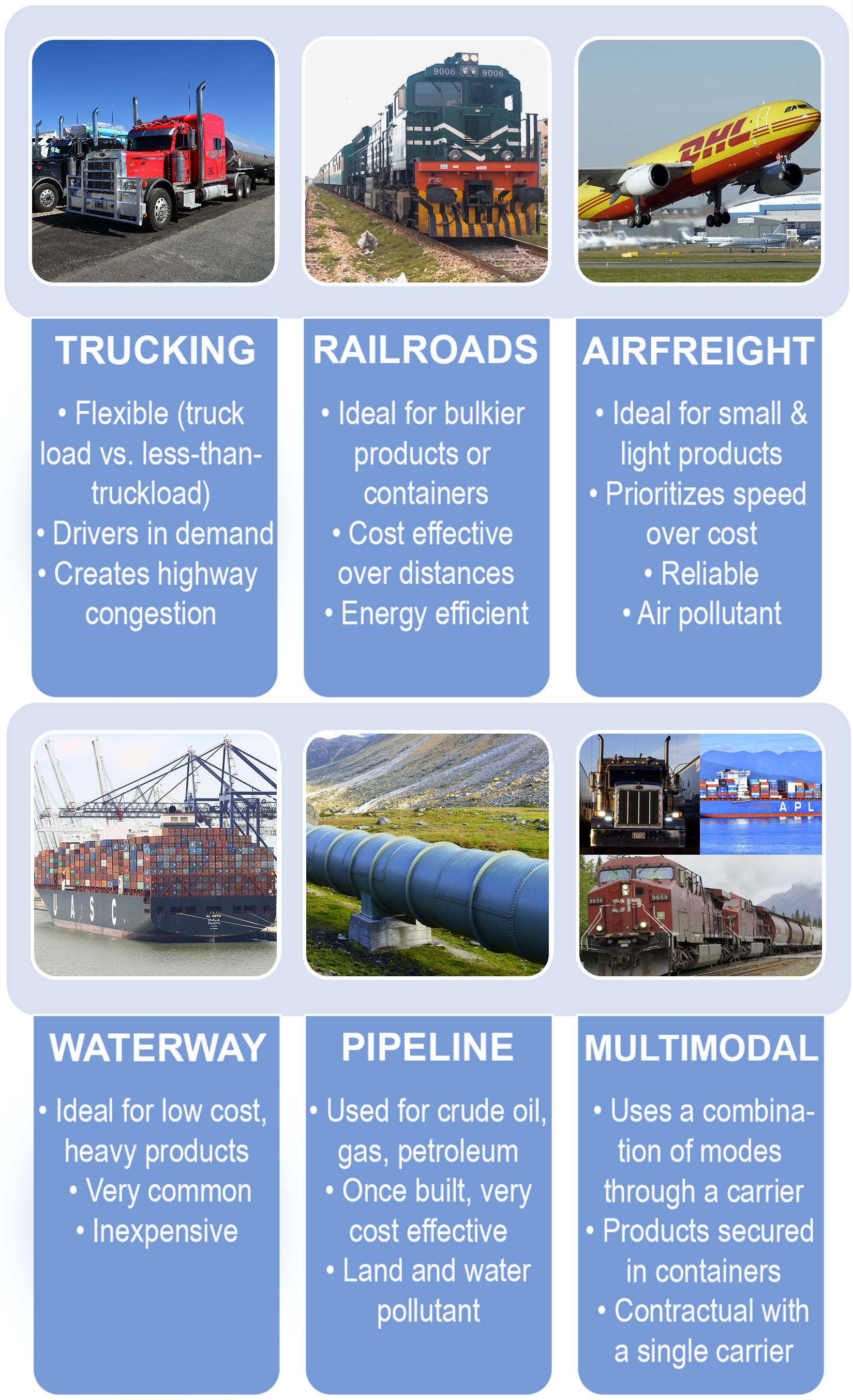
Note. From Faramarzi & Drane (n.d.). CC BY-NC-SA. [Image Description]
There are many types of transport trucks used to move raw materials and products in a supply chain. The front of the truck is commonly referred to as a tractor or cab and couples (attaches) to different forms of trailers. The trailer is determined by the material or product that is being transported. The way in which a transport truck is referred to is often designated by the type of trailer that the tractor or cab is hauling. The following is an examination of some of the most common types of transport trucks and examples of what they transport.
Tanker trucks are used to transport fluids like oil, water, chemicals, and liquefied gasses. For example, gasoline from refineries to gas stations, edible vegetable oils to processing factories and bakeries, and raw milk to dairies. Figure 4.3 depicts a tanker truck that has a large tank as its trailer for holding and transporting liquids.
Figure 4.3
Maseru Industrial Water Tanks

Note. From Hogg, 2009. CC-BY-NC-SA
A flatbed truck can carry many products and as demonstrated in the image below the products are not covered. Flatbed trucks may be used to carry large oversized products or products that do not require protection. Considerations when using this mode of transportation may be permits and safety precautions. For example, a permit since the load being transported is larger than most vehicles, signage saying wide load, and even a safety vehicle escort letting other drivers know that the vehicle may be dangerous to pass and is moving slowly. Figure 4.4 depicts a truck pulling a low-profile trailer that is carrying an oversized and heavy load. Due to the size of this load, special permits and escort vehicles to ensure safety are required.
Figure 4.4
Kenworth
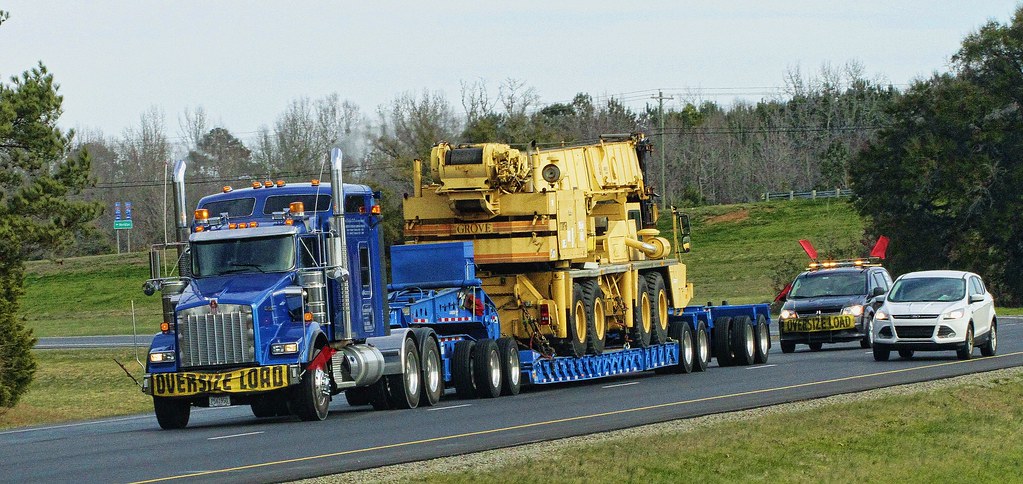
Note. From raymondclarkeimages, 2015. CC BY-NC 2.0.
Trucks with a refrigeration unit attached to the trailer, commonly referred to as a reefer, are used to deliver food products, medical supplies and chemicals requiring low temperatures to be safely transported. Figure 4.5 shows a refrigerated medium-sized truck used for delivering food that requires cold storage during transportation. You may remember in the introduction to this chapter we referenced the need to transport the Pfizer-BioNTech COVID-19 vaccine in cold temperatures. A refrigerated truck was required. Learn more about refrigeration requirements in this document that contains a table with the temperature requirements for the commonly used COVID-19 vaccines.
Figure 4.5
Transport Truck Trapped Under Low Bridge

Note. From Scarborough, 2007. CC BY-SA 2.0
Dump trucks are rugged construction vehicles that can carry very heavy and hard-to-handle bulk material. Dump trucks are able to reach destinations such as rural areas, rough roads, and even into the backyards of people who live in the city. Dump trucks are used for carrying bulk raw materials like sand or gravel. Farmers often use dump trucks to carry bulk crops such as corn or soybeans in the supply chain as the crops are on their way to storage or processing.
This video shows a large truck dumping a load of gravel into a driveway.
Simonson, J. (2007, July 13). Gravel dump and dozer in Fairbanks, Alaska. https://youtu.be/daVXxnKE0W8. Licensed for reuse under CC BY.
What is a dumper?
“A dumper is a construction machine specifically designed to transport unconditioned materials (rubble, sand, earth). The dumper is a member of the earth-moving machine family. This equipment is usually equipped with 4 wheels with an open bucket in front of the driver. The dumper can tip and dump its load.” (Diallo, 2020, para. 1). This article discusses and shows different types of dumping vehicles.
Construction companies and service-orientated companies will typically use pick-up trucks to carry smaller products, packages, parts, and materials. Consumers at the end of the supply chain might use pick-up trucks to carry heavy items or to pull trailers full of products. Figure 4.7 depicts a pickup truck carrying supplies for police.
Figure 4.6
RGP Pick-Up Truck
Note. From Mitchell, 2011. CC BY 3.0
This CNBC article discusses how pick-up trucks dominate the United States automotive sales market: “led by trucks from the Detroit automakers, pickups accounted for five of the industry’s 10 best-selling vehicles in 2020 despite their increasingly higher prices and the coronavirus pandemic” (Wayland, 2021, para. 1).
Transporting by road can limit the size of loads carried due to various factors like low bridges, narrow roads, and roads not designed to carry the weight of heavy loads. If you are moving oversized products, you may need permits and plan your routes carefully. The image below from Perkins STC shows wires being lifted out of the way by utility workers to allow the truck to pass underneath safely.
Figure 4.7
Transport Truck Trapped Under Low Bridge
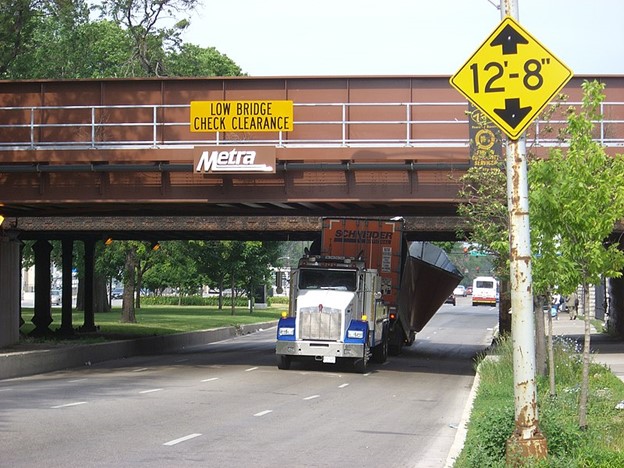 Note. From Scarborough, 2007. CC BY-SA 2.0.
Note. From Scarborough, 2007. CC BY-SA 2.0.
Perkins STC (2017), a company that can move large objects by road, discusses the challenges of moving these products: “the toughest dimension for us to plan, permit, and execute is height. Many of our loads easily reach signs, bridges, and wires and require more time to carefully attend to details associated with a high load. It’s not just finding a route under or around low bridges, it’s about mitigating height with the proper trailer and managing the support required from utility companies, bridge engineers, and railroad vendors in order to minimize the cost and schedule impacts for our customers” (para. 1).
Another mode of small package delivery is bicycle courier. This mode of transportation is excellent for food, parcels, documents, or anything else requiring short and fast journeys. Figure 4.8 shows an example of a Yandex bicycle courier carrying a package in a backpack.
Figure 4.8
Yandex Courier

Note. From Stolbovsky, 2021. CC BY-SA 3.0.
Transporting raw materials and goods by way of railroads commonly referred to as rail can be a very cost-effective way to transport long distances. Historically, it was cheaper to build railroads than it was to build roads. Canada and many parts of the world have extensive rail networks. If your factory or warehouse is located on a rail line, it is very convenient to move a lot of products via rail. Most automotive assembly factories have rail access to allow the efficient moving of their vehicles. In some cases, products have to be transported by truck to a place where the rail line can be accessed and then once at the destination, transferred from rail back to trucks for final delivery. Let’s examine some common types of ways to transport via rail:
Mixed freight as the name implies is a combination of different types of transport cars carrying a variety of cargo that may be raw materials and/or a variety of products. Gondola cars are typically open at the top but in the figure below the gondola cars have been covered. Figure 4.9 below, shows a freight train delivering a mix of covered gondola cars and cargo in boxcars. This type of train is very flexible and can carry a wide variety of products.
Figure 4.9
Class 50 mixed goods, July 1978
 Note. From Lewis, 1978. CC BY 2.0.
Note. From Lewis, 1978. CC BY 2.0.
The demand for oil is exceeding pipeline capacity and as a result, more oil is being shipped by train even though it costs more (Walheimer, 2018). Many chemicals or liquids are moved one tanker car or a few tanker cars at a time. Trains that carry only crude oil over long distances can also be up to a kilometer long. Figure 4.10 shows a train carrying oil tanker cars.
Figure 4.10
Crude Oil Tanker
 Note. From Parker, 2016. CC BY 2.0.
Note. From Parker, 2016. CC BY 2.0.
This article from Global News discusses how cancelling the build of an oil pipeline can shift logistics of moving oil to rail and ship: “oil will still ship but through rail. According to the federal government, as production of oil increased in Western Canada in 2018, it began to outpace pipeline capacity, meaning shipments of crude oil by rail increased to fill the gap, more than doubling from their 2017 levels.” (Dangerfield, 2021, para. 15)
Figure 4.11 shows A very long CN freight train traveling through the mountains carrying raw materials in hopper cars. This can be considered to be an intermodal delivery mode. A typical scenario would see cargo ships unload containers in a coastal port like Los Angeles, California, transfer them to a train that travels to Chicago, Illinois. In Chicago, the containers might be transferred to trucks for their final destination. The systems of these three different modes can safely and reliably be handled in the same types of shipping containers. According to Train Conductor Headquarters (2021), “a freight train length is anywhere between 140 feet [42 m] and 10,000 feet or 1.9 miles [3 km]. However, there were instances where a freight train has reached over 18,000 feet or 3.4 miles [5.4 km), pulling 295 cars” (para. 4). Read the full article.
Figure 4.11
Red and White Train on Rail Near Body of Water During Daytime
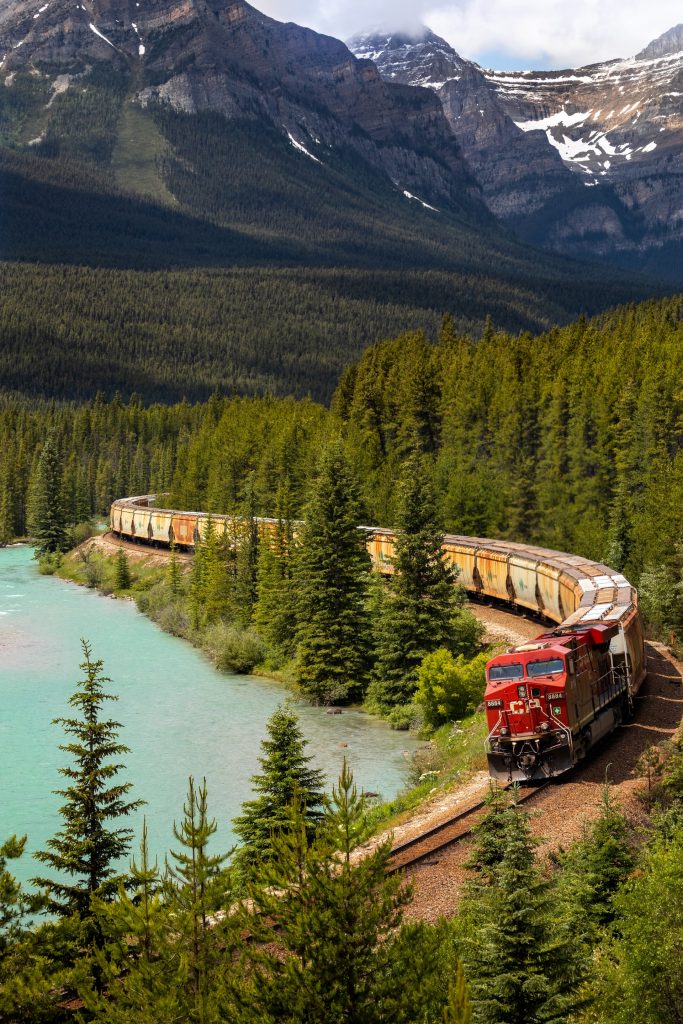 Note. From Holmes, 2020. Free to use under the Unsplash License.
Note. From Holmes, 2020. Free to use under the Unsplash License.
For goods that are expensive, small, and light, air shipping may be a good choice. Air carriers charge by a combination of the weight and size of the shipment. This mode of transport is generally used when speed is more important than cost. Shipping by air is very reliable and can be cost-effective, however, firms may want to consider the environmental impact of the regular use of air shipping. (Faramarzi & Drane, n.d., ch. 7). Cargo Airplanes are a combination of Jets and propeller aircraft that can be dedicated to fly only freight (see Figure 4.12), “Combi’s” (see Figure 4.13, 4.14) that carry both people and freight, or regular passenger airplanes that carry freight in the cargo hold underneath the aircraft. Freighter aircraft require specialized handling equipment. The facilities that support air freight are located beside or directly at airports.
A dedicated freighter aircraft as its name implies is only used to transport goods/freight. There are no windows as it is not used to transport passengers.
Figure 4.12
N744CK LAX There are no windows in the main deck of this airplane because it only carries freight.
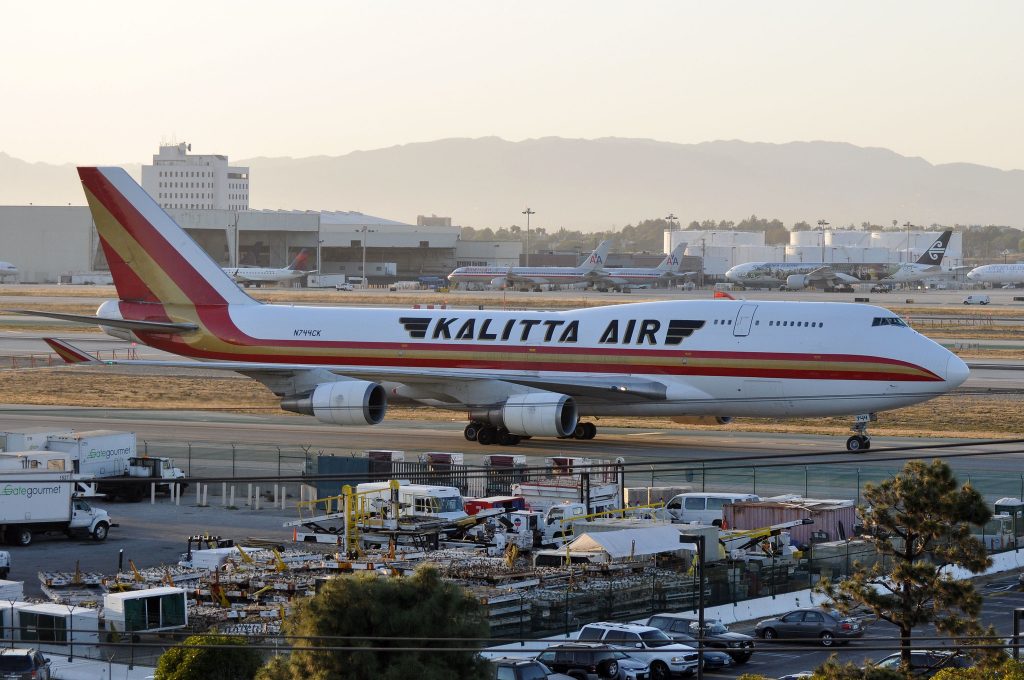 Note. From Salard, 2015. CC BY-SA 2.0.
Note. From Salard, 2015. CC BY-SA 2.0.
UPS operates a fleet of almost 600 aircraft that they own or charter. UPS and FedEx move a lot of LTL and parcel shipping via airfreight.
Aircraft that carry both people (in the front section) and freight (in the back section) are referred to as combination or “combi” jets. This allows flexibility for operators to get revenue from both passengers and cargo. Figure 4.14 shows an illustration of freight being loaded into the back section of a Boeing 747 combi from SAS that would carry passengers in the front section.
Figure 4.13
Boeing 747 Combi from SAS
 Note. From SAS Museum, Norway, 2019. CC BY-SA 2.0.
Note. From SAS Museum, Norway, 2019. CC BY-SA 2.0.
You might be surprised by what is carried in passenger airplane cargo holds, like live lobsters and elephants (Patrick, 2017). Much freight is carried below the decks of the passenger planes, “typically between 45% and 50% of air cargo is carried in the belly holds of passenger aircraft” (Buyck, 2020, para. 5). If you are delivering small packages, the ability to harness the many destinations and frequent schedules offers high service levels and opportunities to get revenue from sources other than passengers. Figure 4.14 shows the cargo hold of a passenger plane that will be carrying freight in addition to your luggage.
Figure 4.14
Cargo Hold
 Note. From Coghlan, 2010. CC BY-SA 2.0.
Note. From Coghlan, 2010. CC BY-SA 2.0.
Many different aircraft types were creatively used to haul supplies to help respond to the COVID-19 pandemic. Passenger aircraft were storing and moving cargo in empty seats. This was a great way to quickly move emergency supplies by adapting capacity not being used by people.
“The first option airlines turned to was simply loading up the large cargo compartments on their big passenger aircraft and flying them without passengers. Long-haul aircraft like the 777-300ER essentially have a passenger cabin on top of a small freight aircraft. The 777 carries more cargo than the 747” (Horton, 2020, para. 13).
The pandemic was not the first time that aircraft was used in creative ways to transport needed supplies. Figure 4.15 shows a Douglas DC3/C47 transport plane that was used during the Second World War to carry troops and goods.
These planes were used to transport supplies, troops, and other vehicles during World War II. They were built in America and were “the workhorse of the Allied air war. Over 10,000 were built during the campaign. The DC3’s speed, range, and carrying capacity made it perfect for the role” (National Army Museum, 1944, para. 1). The DC3 first flew in the 1930s. Over 10,00 were built. Hundreds are still flying today (Boeing, n.d., paras. 2-4).
Figure 4.15
A Jeep Being Loaded Into The Fuselage Of A Dakota Transport Plane, 1944
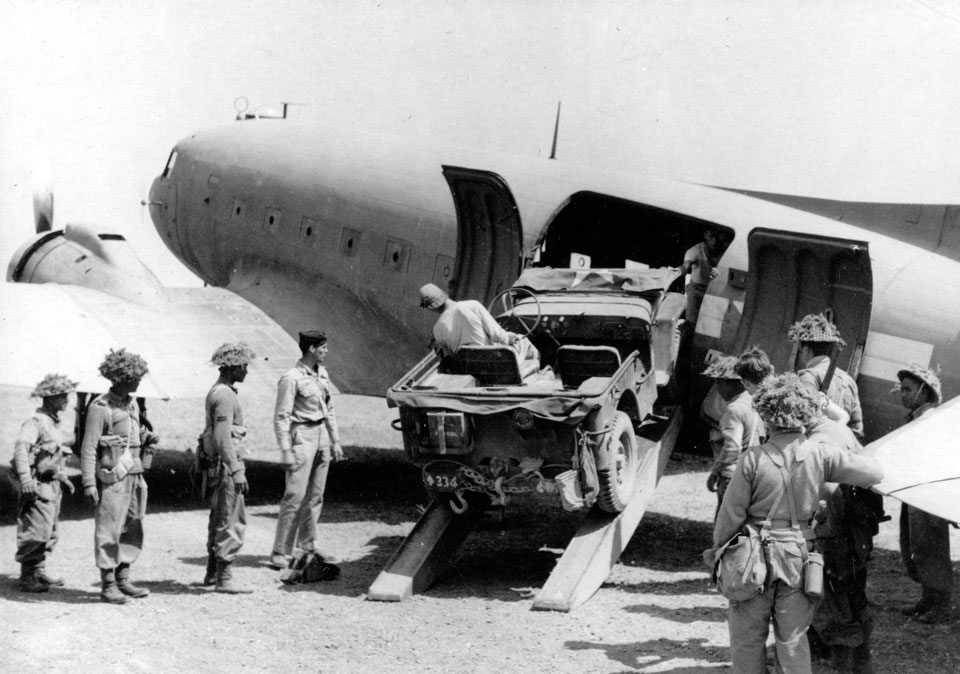
Note. From National Army Museum, 1944. Public domain.
Are drones the future for delivering products to your door? Amazon would like to think so (Amazon, 2021). There are challenges to making drones work, including safety and managing the airspace. The cost will be a significant factor here. Are customers willing to pay a premium to get their products quickly? Check out the video below to see an example of Canada’s healthcare system using drones to deliver time-sensitive materials like organs.
CBC News: The National. (2021, October 12). Lungs for transplant delivered by drone for 1st time: health network [Video]. YouTube. https://youtu.be/BOPsrsrsSYI
Helicopters or rotary-wing aircraft are versatile because they can land in many different places other than an airport. They are used in the transportation and installation of air conditioner units on roofs and, as shown in Figure 4.16 below, antennae on the tops of towers, like the CN Tower in Toronto.
Figure 4.16
Evergreen Sikorsky S-64E Skycrane at Tehachapi (California) Airport
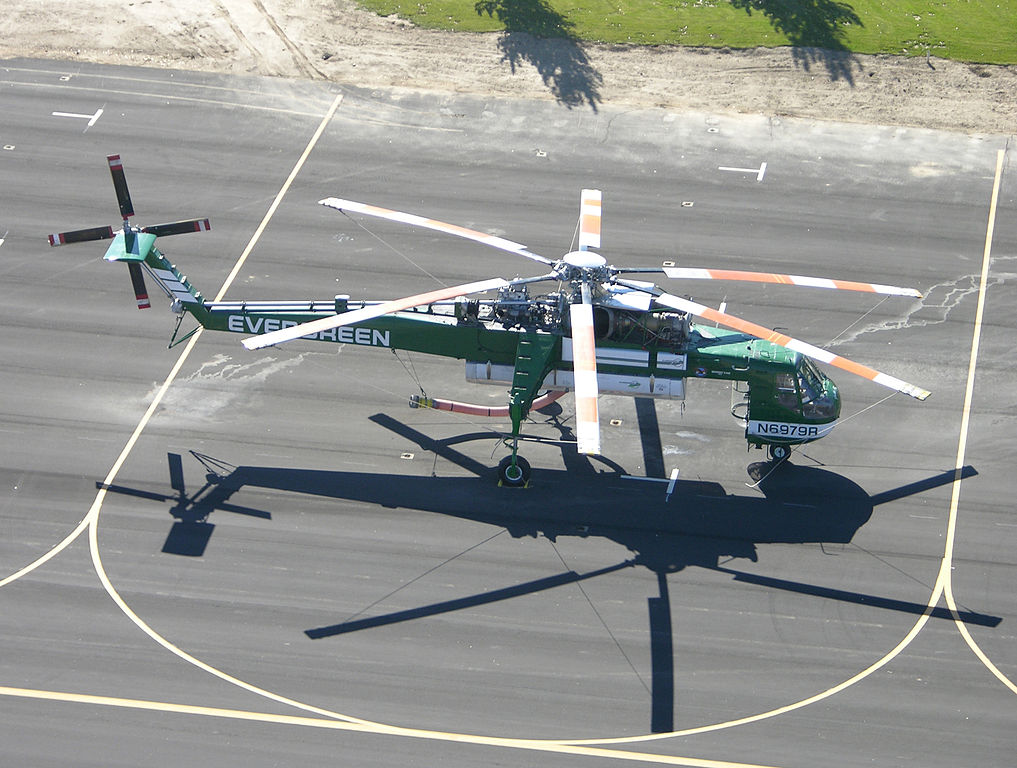 Note. From Radecki, 2006. CC BY-SA 3.0.
Note. From Radecki, 2006. CC BY-SA 3.0.
Blimps are soft-shelled (like balloons) lighter-than-air aircraft due to the helium used in the “balloon” or bladder. Dirigibles are rigid airships that use the much lighter but much more flammable gas, hydrogen. These vehicles were used quite successfully until the 1937 Hindenburg disaster, where many people lost their lives. This ended the era of the use of dirigibles (Grossman, 2017).
Blimps can carry a limited amount of freight and people. They are used to carry cameras, conduct observation, and fly advertising banners. Due to weight restrictions, they are limited as a means of shipping freight. However, there is a resurgence in the idea to make them a productive means of transportation. The Flying Whales company and the provincial government of Quebec, Canada, have been working on a new zeppelin design that can carry freight (Morin, 2021).
Figure 4.17 shows the Good Year blimp in a field. This blimp does not have much capacity for weight but can carry a few people. Blimps are used for sightseeing, observation, and broadcasting messages.
Figure 4.17
Good Year Blimp

Note. From foundin_a_attic, 2017. CC BY 2.0.
It might seem odd to think about rockets to move products, but innovators like Elon Musk think they will become an economical means of transport in the future. If it works, you would be able to get to most places on earth in less than an hour (Ward, 2017, para. 1). Figure 4.18 shows artist’s rendering of a BFR passenger rocket in flight.
Figure 4.18
BFR in Flight
 Note. From SpaceX, 2018. CC BY-NC 2.0.
Note. From SpaceX, 2018. CC BY-NC 2.0.
Shipping by water is a very common way to move goods. You may remember earlier we clarified that shipping as a verb means to transport. In this section, we can look at the various types of sea vessels (ships) that are used to transport in the water. Many different products are shipped by water, but “chemicals, stone, cement, sugar, coal and other heavy commodities” (Faramarzi & Drane, n.d., ch. 7) are among the most common. Millions of containers travel by ship each year. Do you know what goods travel by ship? Read more about the commodities most commonly shipped by water.
In Canada, the St. Lawrence river that runs from the Atlantic Ocean to the Great Lakes serves as Canada’s “marine highway” (St. Lawrence Seaway Management Corporation, 2021, para .1). The St. Lawrence Seaway is a 3,700 kilometer waterway that runs between Canada and the United States. Completed in 1959 the seaway is a major trade artery that serves many industries to ship iron ore, coal, limestone, steel, grain and cement. The cost for shipping by waterways is inexpensive. Most low-cost products are shipped by waterways. (Farmarzi & Drane, n.d., ch. 7).
These are large ships designed to carry standardized shipping containers (see below on containers). These shipping containers usually measure 8′ x 8′ x 20′ or 8′ x 8′ x 40′ and are also used in intermodal shipping. According to Placek (2021) from Statista, “maritime shipping is the backbone of world trade; it is estimated that some 80 percent of all goods are carried by sea. In terms of value, global maritime container trade is estimated to account for around 60 percent of all seaborne trade, which was valued at around 14 trillion U.S. dollars in 2019” (para. 1).
This video from Fluctus describes how container ships work. Did you know that the largest container ships can carry over 20,000 20′ containers?
Intercargo. (2020, July 29). Dry bulk shipping: Sustainably serving the world’s essential needs [Video]. YouTube. https://youtu.be/vfymGkcU77I
Figure 4.19
Container Ship
 Note. From Ulin, 2007. CC BY-SA 2.0.
Note. From Ulin, 2007. CC BY-SA 2.0.
These ships have large open compartments (holds) that can accommodate bulk raw materials like ore, wheat and sugar. Some have their own unloading cranes and equipment, while others depend on the port to load and unload their cargo. Figure 4.20 shows the hold of a bulk carrier. A bulldozer is being unloaded.
Figure 4.20
A Bulldozer Is Loaded On A Bulk Carrier Using A Crane, Prior To Unloading
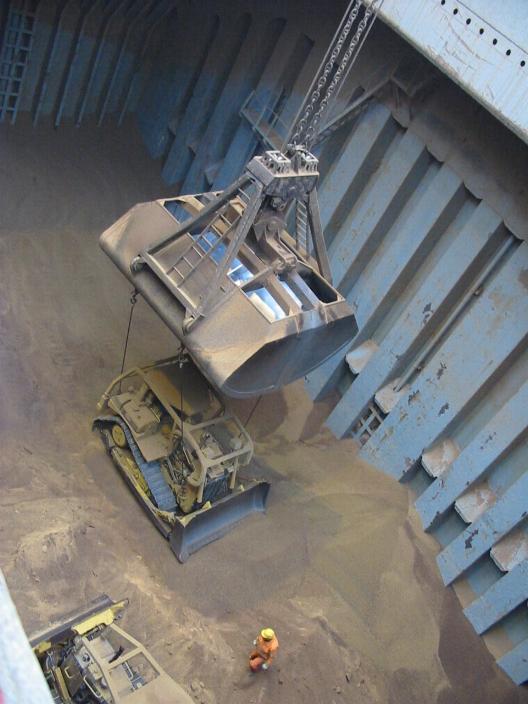 Note. From Cornelissen, 2006. CC BY.
Note. From Cornelissen, 2006. CC BY.
These ships are a type of bulk carrier that transports oil, gasses, and other liquids across the water.
Figure 4.21
Esso Oil Tanker

Note. From Llewelyn, 2012. CC BY-SA 2.0.
Automobile transport ships are large bulky-looking ships with special docks and ramps for loading and unloading vehicles. They are known as Roll-on /Roll-off or Ro-Ro ships.
Figure 4.22
The special-purpose ship used to transport automobiles
 Note. From Garitzko, 2010. Public domain.
Note. From Garitzko, 2010. Public domain.
Barges are used to move on inland waterways and canals. A barge can hold as many as fifteen train box cars or sixty tractor-trailers. They also carry agricultural commodities such as cotton, grain, soybeans, wheat, corn, lumber and wood products, fertilizer, coal, construction materials, metals, sand and gravel. Barges can also transport chemicals. Gasoline, petroleum products, and other chemicals account for 200 million tons of shipping annually on the Mississippi River (Budde & Nicely, 2016, slides 23, 34).
Pipelines are the major way of shipping large volumes of products like “crude oil, natural gas and other petroleum products” (Faramarzi & Dane, n.d., ch. 7). For example, crude oil is shipped from Alberta around Canada and to much of the United States. You can see a 2020 pipeline map to see how extensive the crude oil pipeline network is.
Shipping these products via pipeline is very inexpensive once the pipelines are built. There is concern over the potential environmental impact from spills and leaks, yet others feel that pipelines are the safest way to transport oil and gas when compared to other methods, like rail (Green & Jackson, 2015). Figure 4.23 shows two workers maintaining the Trans-Canyon Pipeline. This pipeline supplies drinking water to the Grand Canyon Park.
Figure 4.23
Trans-Canyon Pipeline (Historic) 2400

Note. From Grand Canyon National Park. CC BY 2.0.
Multimodal or intermodal shipping refers to a combination of different types of transportation to move goods from origin to destination. A typical example is a combination of truck, ship, and train. The goal is to ship the goods as efficiently as possible. In multimodal shipping, the goods are shipped under a single contract with a carrier and can be easily tracked. The goods are stored in a shipping container so that they are not handled when they switch to another mode of transportation. The use of containers increases security, reduces loss and damage, and increases the speed of shipment (Faramarzi & Drane, n.d., ch. 7). Intermodal transport uses at least two modes of transportation and two contracted carriers, usually with the product remaining in the same container throughout the journey. See Figures 4.24 and 4.25 for examples.
Figure 4.24
Talleyrand Terminal Railroad
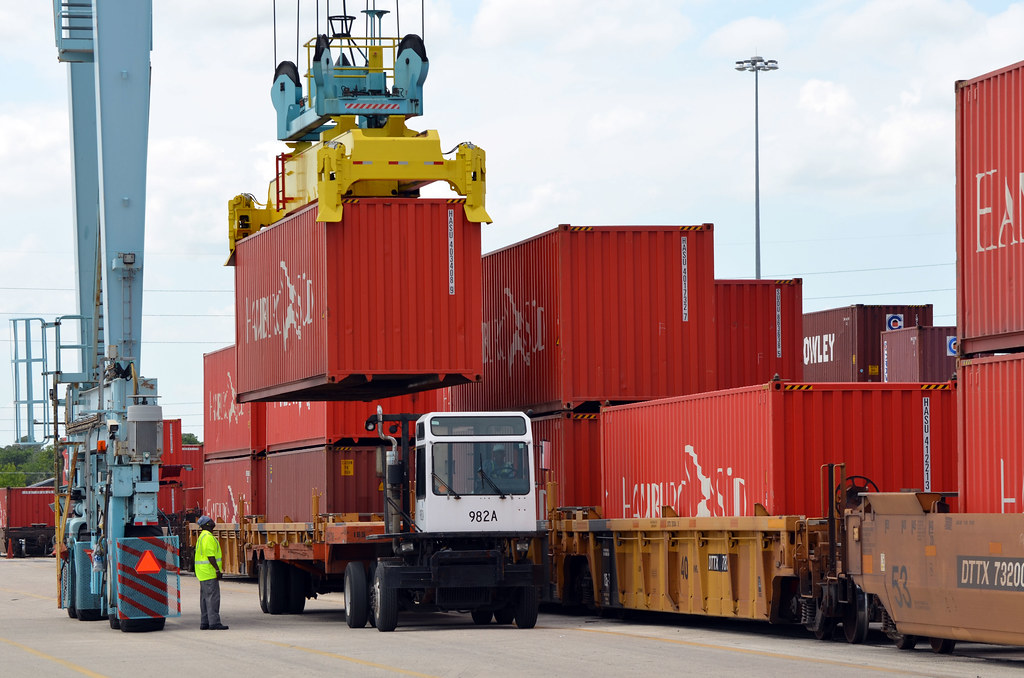
Note. From Jaxport, 2013. CC BY-NC 2.0.
Figure 4.25
Siemens Smartron 192 002 with a Freight Train
 Note. Adapted from Strîmbu, 2020. CC BY-NC-SA 2.0.
Note. Adapted from Strîmbu, 2020. CC BY-NC-SA 2.0.
One consideration to make is that each mode of transport has different restrictions, regulations, and requirements. A shipment that qualifies for rail transportation may not qualify for air transportation. Figures 4.26, 4.27 and 4.28 show windmill blades that have been unloaded from a ship onto a truck to get to their final destination.
Figures 4.26, 4.27, 4.28
Alternative Energy Cargo
Note. [Click on each image to enlarge]. Images from Port of San Diego, 2011. CC BY 2.0.
Containers are packed by a supplier. Standardized container sizes offer in-transit weather protection, faster load/unload times and standardized product handling. Standardization of processes means improved efficiencies and results in lower shipping costs. Containers can be carried on ships, trains or trucks and are a suitable transport method for multimodal shipments.
The standard shipping container is 40′ x 8′ x 8′. Forty-foot and twenty-foot containers are the most widely used for general shipping purposes. Other common sizes are 10-foot, and 45-foot containers.
Hapag-Lloyd, a Germain international shipping company, provides specifications of various sizes of shipping containers.
Figure 4.29 shows a 53-foot container, for use mainly on trucks and trains, that is essentially a standard 40-foot container with extensions added to it.
Figure 4.29
53 Foot Canadian National Container

Note. From Wikideas1, 2016. Public domain.
Skids are platforms constructed of wood, plastics or other materials on which products can be placed and secured for safe movement. A standard pallet (skid with a bottom deck) “measures 48″ X 40″ with each deck board being 3 ½” wide 5/16″ thick” (C.H. Robinson Worldwide, Inc., 2021, para. 1).
Figure 4.30
Pallets
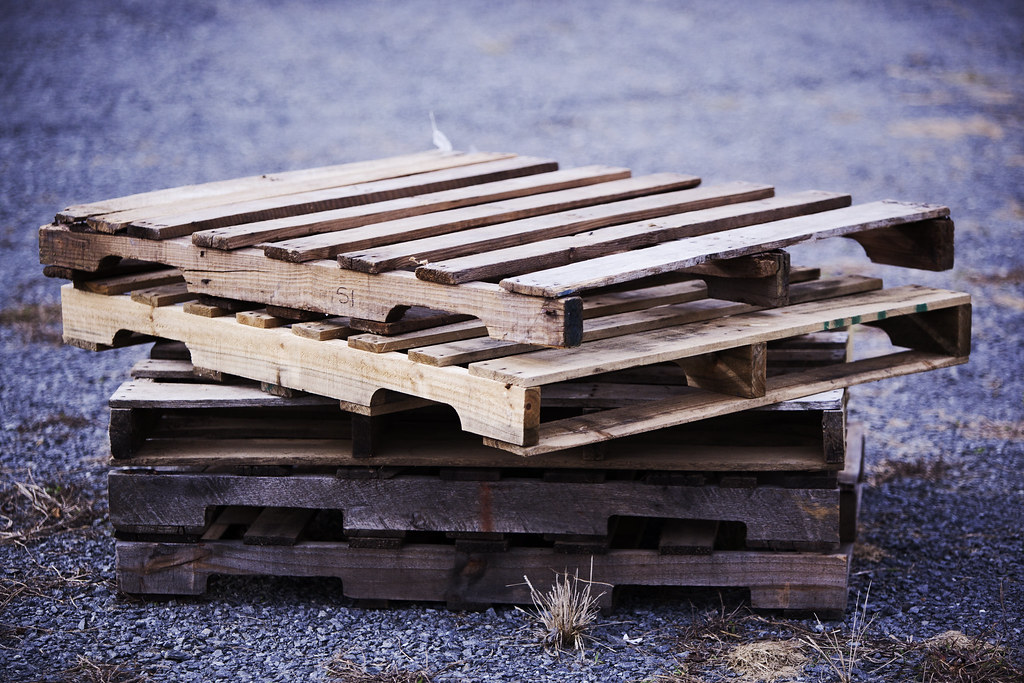
Note. From Stoneburner, 2011. CC BY 2.0.
Packaging and protecting products for shipping is a huge subject to tackle. This section provides a very high-level overview only. Packaging protects products but is also used to help market products and ensure they are noticed. The most common purposes of packaging include the following:
There are considerations to make when selecting packaging including structural design, marketing, shelf life, quality assurance, logistics, legal, regulatory, graphic design, end-use, and environmental. The design criteria, performance (specified by package testing), completion time targets, resources, and cost constraints need to be established and agreed upon.
The packaging section was adapted from The Purpose of Packaging and Packaging Considerations from Boundless Marketing by Boundless. Licensed for reuse under CC BY-SA 4.0.
These elements are related to the description of the product discussed earlier in this chapter. It is best to consider packaging requirements in the design phase to avoid surprises and increased costs when you first ship your products. Environmental concerns and what happens to both the product and its packaging should be considered to minimize negative impacts from your packaging and shipping choices.
Improper packaging and handling during transportation can lead to broken and damaged products. Poor packaging can also lead to unnecessary waste and contribute to pollution, especially if the packaging materials are not recyclable.
This GWP Group article has some excellent examples of problematic packaging practices, including wasteful, misleading, and hilarious packaging fails. Ask yourself, what could have been done better?
Figure 4.31 shows a broken shipping container and a damaged product spilling out of it. The ship itself seems to be leaning heavily indicating that there may be more damage to products in other containers.
Figure 4.31
Broken Container on a Reefer
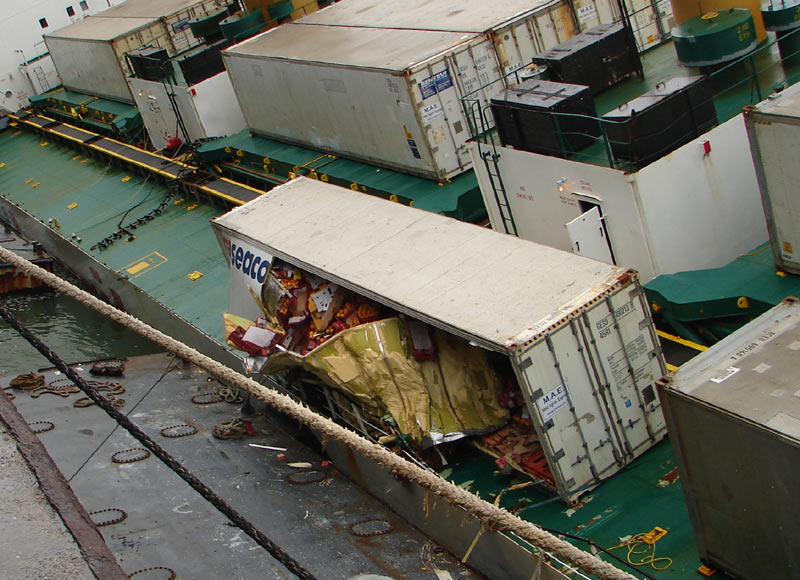
Note. From Cozanet, 2006. GNU Free Documentation License.
Food delivery also depends on appropriate packaging and safe handling. Figure 4.33 shows a damaged pizza as received when delivered from Motorino Pizza, East Village, NYC. This failure will results in extra costs and using the reverse supply chain or another delivery to fix the problem.
Figure 4.32
Motorino Pizza. East Village, NYC.
 Note. From Mikoy, 2020. CC BY 2.0.
Note. From Mikoy, 2020. CC BY 2.0.
An interactive H5P element has been excluded from this version of the text. You can view it online here:
https://ecampusontario.pressbooks.pub/logistics001oerfc/?p=55#h5p-8
In 1967, the design, planning, and execution of logistics functions ensured that two people could travel to the moon. Appropriate packaging and modes of transportation were used to ensure their safe return. Your logistics decisions will not likely be as complicated as those required for the Apollo 11 mission; however, all movement of products needs to consider alternatives, impacts, and the total cost of moving and storing them.
This image shows a picture of Buzz Aldrin, taken by Neil Armstrong during the Apollo 11 mission to the moon. Incredible logistics were necessary to ensure a successful journey that returned knowledge, stories, pictures, and lunar rocks: “the two astronauts spent 21 hours on the lunar surface and returned 46 pounds [20.8 kg] of lunar rocks” (Redmond, 2008, para. 3). The logistics necessary to do this were astounding, as were the many modes of transportation used: cars, rockets, helicopters, ships, trucks, barges, trains, airplanes.
Figure 4.33
Apollo 11 Photo of Buzz Aldrin by Neil Armstrong
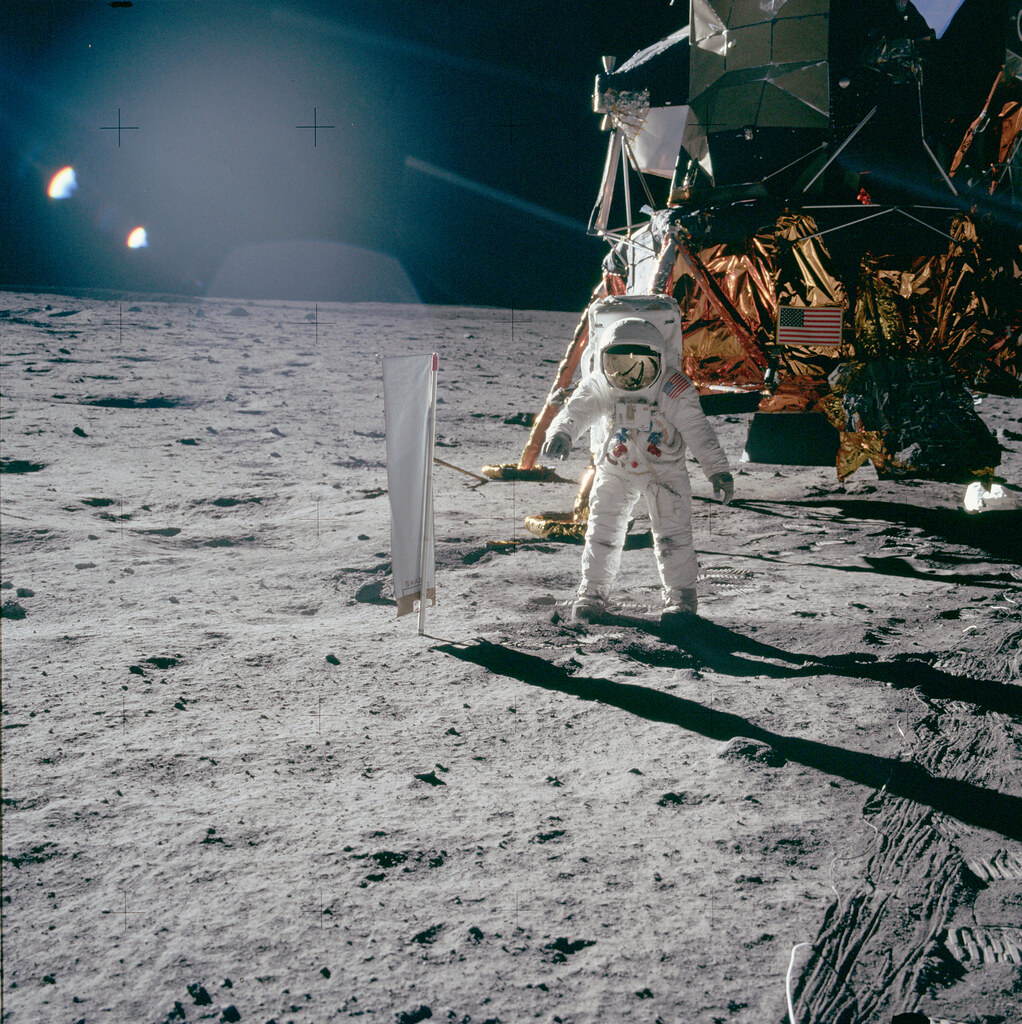
Note. From Project Apollo Archive, 2019. Public domain.
There are many modes or ways to ship products. In this chapter, we have identified and discussed common modes of transportation. Airplanes are fast but expensive and cannot carry large and heavy things. Ships are slow and limited to waterways, but their cost per unit is low, and they can carry almost anything. Transport trucks are a flexible mode used in almost every supply chain, but they depend on qualified drivers, regulations, and road rules. We have examined packaging options and the consequences of poor packaging. The specifications, cost, speed, customer requirements, and characteristics of the product help guide the logistical choice of which mode of transportation is most appropriate.
Boeing. (n.d.). DC-3 commercial transport. https://www.boeing.com/history/products/dc-3.page
Boundless. (n.d.). Chapter 10: Branding and packaging. Boundless Marketing. http://kolibri.teacherinabox.org.au/modules/en-boundless/www.boundless.com/marketing/textbooks/boundless-marketing-textbook/branding-and-packaging-10/index.html
Buddes, M., & Nicely, T. (2016). Exploring the economics of using barges on the mississippi river to transport agricultural commodities. National Agriculture in the Classroom. https://naitcconference.usu.edu/archive/2016/Uploads/pdfs/14601_2188MargaretBudde.pdf
Buyck, C. (2020, March 26). More airlines are stuffing cargo into passenger seats to counter Coronavirus slump. Forbes. https://www.forbes.com/sites/cathybuyck/2020/03/26/airlines-spot-revenue-opportunity-and-use-their-passenger-aircraft-to-ship-urgent-cargo/?sh=3973cdf27c68
C.H. Robinson Worldwide, Inc. (2021). Standard pallet sizes & dimensions. Freight Quote. https://www.freightquote.com/how-to-ship-freight/standard-pallet-sizes/
Coghlan, M. (2010, October 23). Cargo hold [Photographer]. Flickr. https://www.flickr.com/photos/mikecogh/5113895265/in/photolist-8MU3U2-6h1Vn1-p7VAAK-8MX97L-6xno7R. Licensed for reuse under CC BY-SA 2.0.
Cornelissen, D. (2006, March 4). A bulldozer is loaded on a bulk carrier using a crane, prior to unloading [Photograph]. Wikimedia Commons. https://commons.wikimedia.org/wiki/File:Bulldozer_loaded_on_bulk_carrier.jpg. Licensed for reuse under CC BY.
Cozanet, H. (2006, July 6). Broken container on a reefer [Photograph]. Wikimedia Commons. https://commons.wikimedia.org/wiki/File:Broken_container_on_reefer.jpg. Licensed for reuse under GNU Free Documentation License.
CTV Edmonton. (2021, July 9) Drone deliveries set to take off from Edmonton International Airport. https://edmonton.ctvnews.ca/drone-deliveries-set-to-take-off-from-edmonton-international-airport-1.5503501
Dangerfield, K. (2021, June 10). Keystone XL pipeline is officially dead. What does this mean for Canada? Global News. https://globalnews.ca/news/7937529/keystone-xl-pipeline-cancelled-alberta-canada/
Debes, J. (2015, July 22). What does a bushel mean to me? Kansas Wheat. https://kswheat.com/news/what-does-a-bushel-of-wheat-mean-to-me
Faramarzi, H., & Drane, M. (n.d.) Introduction to operations management. Seneca College Pressbooks Network. https://pressbooks.senecacollege.ca/operationsmanagementintro/. Licensed for reuse under CC BY-NC-SA.
foundin_a_attic [username]. (2017, November 22). Good year blimp [Photograph]. Flickr. https://www.flickr.com/photos/foundin_a_attic/38526357496/in/photolist-21GrDR3-21MZMY6-21Mv4Ke-21GrZmA-DE7b8h-21GUQo1-21GrJdu-21GW9fw-21MvtGn-DDE51E-21D4FLx-GQRqLM-21MvLKa-ZG9Cio-21MvnmX-21JCJcQ-2iP7m51-2iP7koG-2iP7kkL-2hMykRi-VBZxxe-2hQQkhP-2iJQynF-2kcmkRy-25443t7-21K657N-Zr1Lc6-GQRUUk-Vzzpa3-2cVgDZE-2cVgGsf. Licensed for reuse under CC BY-SA 2.0.
Garitzko. (2010, March 21). Car carrier [Photograph]. Wikimedia Commons. https://commons.wikimedia.org/wiki/Category:Cygnus_Leader_(ship,_2007)#/media/File:Car_carrier_Cygnus_Leader.jpg. Public domain.
Grand Canyon National Park. (2014, January 2). Trans-canyon pipeline (historic) 2400 [Photograph]. Flickr. https://www.flickr.com/photos/grand_canyon_nps/11720986694/in/photolist-iRK7Zu-iRH7Pz-iRJFoi-iRGEhM-eBfr9Z-eiZM8p-bhYQXV-iRGCvv-iRLNeG-iRLTtQ-iRGMya-iRHY6t-iRJm8V-iRJV8d-iRJsov-iRHWj2-iRM4Yh-j3nNdi-2k1vewD-j3q7zJ-2m1K4K5-iRLXHS-iRJfcB-iRK68J-iRH9K8-iRJCMY-iRLRPs-iRJ6Tx-iRJEi3-j3pPXA-iRGu9R-j3pWVd-j3nGNv-j3p4nT-j3nzwM-j3nLU6-j3q5XA-j3nD4X-j3pgka-j3rZ6J-j3prYz-j3ptmz-2jVLQPF-2jVMBWL-iRGCN2-iRvQ3j-iRxWtd-2jVMCuQ-iRvgMr-iRu1zB. Licensed for reuse under CC BY 2.0.
Great Lakes St. Lawrence Seaway System. (2022). The St. Lawrence Seaway: A vital waterway. https://greatlakes-seaway.com/en/the-seaway/
Green, K.P. & Jackson, T. (2015, August). Safety in the transportation of oil and gas: Pipelines or rail? Fraser Research Bulletin.
Grossman, D. (2017). The Hindenburg disaster. Airships.net. https://www.airships.net/hindenburg/disaster/
Hogg, J. (2009, June 25). Maseru industrial water tanks [Photograph]. Flickr. https://www.flickr.com/photos/worldbank/14112020821. Licensed for reuse under CC BY-NC-SA.
Holmes, A. (2020, May 11). Red and white train on rail near body of water during daytime [Photograph]. Unsplash. https://unsplash.com/photos/oEIFOoC3gi0. Free to use under the Unsplash License.
Horton, W. (2020, April 1). 7 unusual ways aircraft now fly cargo during Coronavirus outbreak. Forbes. https://www.forbes.com/sites/willhorton1/2020/04/01/7-unusual-ways-aircraft-now-fly-cargo-during-coronavirus-outbreak/?sh=682e181335b1
Jaxport. (2013, April 9). Talleyrand terminal railroad [Photograph]. Flickr. https://www.flickr.com/photos/jaxport/8634966179/in/photolist-ea3sBe-ea2TvZ-ea8yuU-ea3sVt-ea98By-ea3t4k-ea3ErH-ea98jG-ea98wm-7m7eBi-ft1dYT-ft1dUx-ft1e3M-9n4VKu-ea2Tpn-fu1fSA-5BsWqT-9n1Rtz-9n4VfJ-9n4W2j-9n1TgZ-zvdqkf-bbeug8-4VmRYB-4VmRV2-bbeupg-bbdsW8-4VmS5V-fu19rw-ishyYN-e1AYwz-ish1Tz-ishyew-ishAe3-isgYBk-ishAsj-ishS1F-ishyD9-isgYxH-ishzFQ-ishfCY-isgYcT-ishRJD-ish14i-ishfs7-diwJXR-diwJSg-diwK7k-fYfss8-eR9Hs9. Licensed for reuse under CC BY-NC 2.0.
Lewis, B. (1978, July). Class 50 mixed goods, July 1978 [Photograph]. https://commons.wikimedia.org/wiki/File:Class_50_mixed_goods,_July_1978.jpg. Licensed for reuse under CC BY 2.0.
Llewelyn, H. (2012, September 12). Esso oil tanker [Photograph]. Flickr. https://www.flickr.com/photos/camperdown/33464339572/in/photolist-SZ8ugW Licensed for reuse under CC BY-SA 2.0.
Logistics Plus. (2017, July 19). FTL versus LTL – What’s the difference? https://www.logisticsplus.com/ftl-versus-ltl-whats-the-difference/
Mikoy, C. (2020, June 14). Motorino Pizza. East Village, NYC [Photograph]. Flickr. https://www.flickr.com/photos/carlmikoy/50009042808/in/photolist-2jc8q91-6yorKu. Licensed for reuse under CC BY 2.0.
Mitchell, H. (2011, October 23). RGP pick-up truck [Photograph]. Wikimedia Commons. https://commons.wikimedia.org/wiki/File:RGP_pick-up_truck_(3).JPG. Licensed for reuse under CC BY 3.0.
Morrin, P. (2021, April 4). Giant airship project, touted as solution to remote shipping, ‘on track’ says company. CBC. https://www.cbc.ca/news/canada/north/flying-whales-schedule-1.5973192
National Army Museum. (1944). A jeep being loaded into the fuselage of a Dakota transport plane, 1944 [Photograph]. National Army Museum Online Collection. https://collection.nam.ac.uk/detail.php?acc=1974-09-79-110
Parker, P. (2016, April 16). Crude oil tanker [Photograph]. Flickr. https://www.flickr.com/photos/45131642@N00/25862940183/in/photolist-Fpqk4M-as5hWx-HujmyJ-25yuFVS-rLLDam-BuQh6X-qQ6pz8-KYYcFD-VDAYYP-LQRmBk-dq25pM-aEiGZB-tQDQt5-9wVpLU-PGgyEm-dkyhHv-9u3d97-9wVGoJ-9wKyQu-9u3dK7-cnJYuW-DgJbpw-LAHQZB-23zJSPz-9wVNws-dkgkvB-KSgpz2-9xrvuh-9tZdKv-9CeoiM-VB3zES-VB3zss-9CekVr-BtGMLR-9tE9hx-L6eJFR-9Chgpw-o86ExH-2cRw2ZN-HyWTZs-KSgn6p-9Chhxs-K3BPmR-KpfFSX-ecz3SU-JPkPJP-JZsRkR-21x21sA-KxPNh5-285qpAN. Licensed for reuse under CC BY 2.0.
Patrick, L. (2017, July 3). Curious cargo: 20 strange things you didn’t know were flying with you. Fodor’s Travel. https://www.fodors.com/news/travel-tech/curious-cargo-20-strange-things-you-didnt-know-were-flying-with-you
Perkins Specialized Transportation Contracting. (2017, February 20). What are the costly truths about moving high loads. Perkins STC. https://www.perkinsstc.com/oversize-news/2017/2/16/costly-truths-about-high-loads
Pfizer Incorporated (2022). COVID-19 vaccine U.S. distribution fact sheet. https://www.pfizer.com/news/articles/covid_19_vaccine_u_s_distribution_fact_sheet
Placek, M. (2021, September 23). Container shipping – statistics & facts. Statista. https://www.statista.com/topics/1367/container-shipping/
Port of San Diego. (2011, May 12). Alternative energy cargo [Photograph]. Flickr. https://www.flickr.com/photos/portofsandiego/with/5715895393/. Licensed for reuse under CC BY 2.0
Project Apollo Archive. (2019, July 20). Apollo 11 photo of Buzz Aldrin by Neil Armstrong [Photographer]. Flickr. https://www.flickr.com/photos/projectapolloarchive/48334391441/in/photolist-2gD9oCz-6GnwsT-6Gwkki-fpXZ5W-jkUD3P-2ikPbHC-fCYkb5-bk9aWd-bk99f1-bk9abu-6GAp8y-bk97sf-fdv21M-6GwkqB-RMXSAz-6GAp5s-dfCjgc-cYLLtb-6GAoZG-JJVmha-6H1RKr-cYMbkS-cZYRCy-fpHXBi-24JRtkr-ciabm1-6H1RHT-d753qj-azeBAg-GfPeKH-8wyRX2-dSVfXC-bWG3LJ-T8Ap1Q-6BJt9b-6BJt49-6HwwLZ-aMy9CV-wV2cKN-cAVfy3-2goHS4w-oaTR5-2gCTGN8-6H2f4k-64jJ6Q-6NhXxp-nXYBSM-8GrsNX-WRtwvR-8pkqMh. Public domain.
Radecki, A. (2006, November 11). Evergreen Sikorsky S-64E Skycrane at Tehachapi (California) Airport [Photograph]. Wikimedia Commons. https://commons.wikimedia.org/wiki/File:Evergreen-skycrane-N6979R-tehachapi-061117-02cr.jpg. Licensed for reuse under CC BY-SA 3.0.
Raymondclarkeimages. (2015, January 9). Kenworth [Photograph]. Flickr. https://www.flickr.com/photos/rclarkeimages/16086398598/in/photolist-qvuZRY-cZrjiL-qvDz7P-2kMujvY-D5VGhs-2hPKn5y-2iUKFjv-tSduTs-Wu2uoU-r3iwkC-zQRXY2-sdau1T-De5pMM-sdQPcN-coGVsy-pt8iU9-daYZco-cdmtuW-qvCfmg-cFpRnQ-pqy9nX-2hf4oS8-nuiDHg-247b3cS-qvDyHx-cYLewh-hJZBgF-fziDy7-YNP3y9-coGUZy-phsEva-y9uqcL-fbkDTq-CquLCQ-dh2a9M-eXbfUS-cvSiAJ-cd6nPQ-nd6Mf7-bEzNf9-cTemfA-nuDY51-cFpR8d-bTux5H-nwDuYt-eTDkai-cvSjf5-dVtmJv-2gCzTRb-RQnfGF. Licensed for reuse under CC BY-NC.
Redmond, C. (2008, November 12). Apollo 11: “One giant leap”. NASA. https://history.nasa.gov/apollo/apo11.html
Salard, E. (2015, April 15). N744CK LAX [Photographer]. Flickr. https://www.flickr.com/photos/airlines470/24085234315/in/photolist-CGk83B-2dRJaWj-QFE9Jd-2m8DdMi-2iR8BzH-uPdPpj-2iN8zxe-2kVBLnA-2iJeaLP-2iJgTtq-2iFcv3u-YLub7s-2iJgTzx-2kT5jHQ-2gVy6gw-2m6rvAD-2iJiwiS-FUxGpH-2iJiwfv-KBKrNi-2iJgTtf-rrNYoZ-rXGogm-jxgYZK-2iF9GU8-2jp8wGT-nwiEYe-fyjadp-qZGjyc-NQJk3j-YWcahj-rHZin6-2iUSbcN-4oqCDm-r57R7h-2m3PAPr-oxSMHg-cEgDiy-9eyC5v-2mFtQfp-prsv7a-2iPWihB-S2dBUa-2mqDeT1-r9hzEj-asysFJ-asyp5d-asvNqr-2iPTyU6-PkYXYC. Licensed for reuse under CC BY-SA 2.0.
SAS Museum Norway. (n.d.) Cargo on the half of the main deck – 1970’s. Openverse. https://wordpress.org/openverse/image/847036a7-e037-480a-a870-66b14b8595ef. licensed for reuse under CC BY-SA 2.0.
Scarborough, K. (2007, June 21). Truck crunch [Photograph]. Wikimedia Commons. https://commons.wikimedia.org/wiki/File:Truck_Crunch_(1)_(688043114).jpg. Licensed for reuse under CC BY-SA 2.0.
SpaceX. (2018, September 20). BFR in flight [Digital rendering]. Flickr. https://www.flickr.com/photos/spacex/30934146988/in/photolist-P8xAaS-P8xA3Y-P8xA7f-29SRRFx-29SRRR2-P8xAcq/. Licensed for reuse under CC BY-NC 2.0.
Stolbovsky (2021, January 2). Yandex courier [Photograph]. Wikimedia Commons. https://commons.wikimedia.org/wiki/File:Yandex.Eda_courier_01.jpg. Licensed for reuse under CC BY- SA 3.0.
Stoneburner, W. (2011, October 10). Pallets [Photograph]. Flickr. https://www.flickr.com/photos/waltstoneburner/6244758934/in/photolist-avQ2gu-jGpuRd. Licensed for reuse under CC BY 2.0.
Strîmbu, C. (2020, July 9). Siemens Smartron 192 002 with a freight train [Photograph]. Flickr. https://www.flickr.com/photos/161353030@N02/50168698871/in/photolist-2k5iPst-2j5jwxc-2ihbf3g-2jreGjK-2k7tUxR-2jjEsCL-2m7eSsm-2jmurw8-2jH7paE. Cropped. Adapted and licensed for reuse under CC BY-NC-SA 2.0.
Ulin, A. (2007, June 9) Container ship. [Photograph]. Wikimedia Commons. https://commons.wikimedia.org/wiki/File:Container_ship_Hanjin_Helsinki.jpg. Licensed for reuse under CC BY-SA 2.0.
Train Conductor Headquarters. (2021). How long is a train? Freight, passenger. Maximum allowed length? https://trainconductorhq.com/how-long-is-a-train/
Walheimer, B. (2018, August 14). Why transporting oil by rail Is popular, despite the cost. Chicago Booth Review. https://www.chicagobooth.edu/review/why-transporting-oil-rail-popular-despite-cost
Ward, P. (2017, October 3). Elon Musk wants to fly you to any city in the world in under an hour. Culture Trip. https://theculturetrip.com/north-america/usa/new-york/articles/elon-musk-wants-to-fly-you-to-any-city-in-the-world-in-under-an-hour/
Wayland, M. (2021, January 10). Pickup trucks dominate America’s 10 best-selling vehicles of 2020. CNBC. https://www.cnbc.com/2021/01/08/pickup-trucks-dominate-americas-10-best-selling-vehicles-of-2020.html
Wikideas1 [username]. (2016, December 23). 53 Foot Canadian National Container [Photograph]. Wikimedia Commons. https://commons.wikimedia.org/wiki/File:Canadian_National_53_foot_container.jpg. Public domain.
Figure 4.1: This figure shows a generic product supply chain flowchart: Raw materials selection then logistics (movement and storage, warehouses and bulk storage), then manufacture stage, then logistics (movement and storage, distribution centres and warehouses), to retail stores and/or consumers, then to product end use. [Back to Image]
Figure 4.2: This figure summarizes various modes of transportation. From left to right in the top row of the diagram, trucking is flexible, drivers in demand and creates highway congestion. In the middle, railroads are ideal for bulkier products or containers, cost-effective over distances and energy-efficient. On the right side, airfreight is ideal for small and light products, prioritizes speed over cost, reliability and air pollutants. In the bottom row from left to right, the waterway is ideal for low cost, heavy products, very common and inexpensive. In the middle of this row, there is a pipeline used for crude oil, gas, petroleum, very cost-effective once built and land and water pollutants. On the right of this row, there is multimodal, which uses a combination of modes through a carrier, products secured in containers and contractual with a single carrier. [Back to Image]
Raw materials and products are stored in warehouses, buildings, and other types of locations while waiting to be transported. When determining which type of storage facility to use, consideration must be given to the type of material or product. You may remember that in a previous chapter, we discussed the need to temperature control COVID-19 vaccines during transit and storage. Vaccines are not the only products requiring specific conditions to protect them during their movement and storage. In this chapter, we will explore the different types of warehousing available, the role that warehouses and distributions centres play in a supply chain, and review the type of equipment used to load and unload products at warehouses.
An interactive H5P element has been excluded from this version of the text. You can view it online here:
https://ecampusontario.pressbooks.pub/logistics001oerfc/?p=57#h5p-9
Logistics includes both moving and storing products. Warehouses, buildings, and locations for storage are typically used to hold products that have just been made, are in transit, or are at their destination awaiting a customer order. As depicted in the image below storage (also referred to as warehousing) may take many forms such as raw material storage, finished good storage, in-transit storage, and storage in distribution centres.
The name that a company chooses to call its warehouses may vary. For example, Amazon refers to its warehouses and distribution centers as fulfillment centers (Amazon FC Tours, 2021). A typical warehouse may store various products in boxes, on skids, and on racks. In a warehouse, you will see the use of labels and packaging that identifies one product from another. People and machines such as manually operated forklifts, cranes, or fully automated robots will move products within the warehouse.
A Product Supply Chain

Note. From Kukhta, 2021. [Image Description]
In a supply chain planning is done to determine the required amount and type of warehousing and once products are received most general warehouses follow a similar process such as this one:
Amazon’s Fulfillment Centres use a seven-step warehouse process that is a slightly different process than listed above. Amazon receives products that are ready for consumers. Watch this video and see if you can identify them.
This video link takes you through this process with a virtual tour of an Amazon Fulfillment Center.
Amazon FC Tours. (2021, April 10). Amazon fulfillment center video tour. YouTube. https://youtu.be/UAKPoAn2cB0
Amazon’s Seven-Step Warehouse Process (Amazon FC Tours, 2021): Consider How it Differs or is Similar to General Warehouse Processes
How is Amazon’s seven-step warehouse process similar or different from the general warehouse processes?
Raw materials and products may require the same or different types of warehouses depending on where they are in the supply chain. Where they are in the supply chain can be subjective and depends on the perspective of those involved in the same product supply chain, one organization’s finished product is another organization’s raw material. In Figure 5.1 not all materials or products required the same number of supply chain steps. Warehousing works in the same way, the number of warehouses is determined by the materials or product, their transportation and storage needs, the distribution network used, and cost.
For example, Figure 5.2 shows the different types of warehouses at different points in the supply chain. Inventory at the origin awaiting shipment needs logistics to move it to the manufacturing process and then for its journey to the customer. The product is stored in finished goods storage area, an internal warehouse, or a shipping dock. Many different types of warehouses can be used while products are in transit, depending on the type of product and its transportation and distribution arrangements. At their destination, products end up at receiving docks or receiving areas, where they are processed and placed in the customer’s warehouse or a storage area. Outside storage areas and storage yards might be used throughout the supply chain where the product is suited to this form of storage, as shown in Figure 5.5.
Figure 5.2
Logistics from Suppliers to Customers
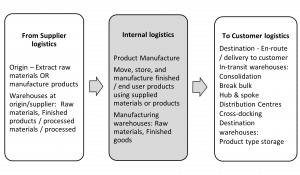
Note. From Kukhta. [Figure Description]
Warehouses at the raw materials and Product Manufacturing stages refer to the stages where either raw materials are waiting to manufactured or where raw materials have been processed or manufactured into a finished product. That finished product then gets stored in a finished goods warehouse as they wait for transport further down a supply chain. In the case of raw materials, raw materials are piled as they wait for transport into a supply chain. In the case of automobiles, they are stored in outdoor lots outside of their manufacturing plants while they wait to be picked up for transport to car dealerships.
Figure 5.3 shows products on racks and shelves in boxes and pallets that have finished processing and are awaiting shipment.
Figure 5.3
Industrial Hall
Note. From Millennium Luxury Coaches, 2010. CC BY-NC-SA 2.0
Figure 5.4 shows trucks waiting outside ready to load raw material from the raw material pile behind to be shipped to the next step in the supply chain process. In this case, there is no warehouse building.
Figure 5.4
Trucks at a Mine
Note. From Ian BC North, 2006 CC BY-NC 2.0
Figure 5.5 shows an auto manufacturing plant. Outside an automotive manufacturing plant, there are large storage areas (sometimes referred to as lots) of cars awaiting pick up for transport that look similar to this. These cars are awaiting shipment to their next destination in the supply chain, car dealerships.
Figure 5.5
New Cars Being Stored
Note. From Jaxport, 2013. CC BY-NS 2.0.
Storage can take on different forms during the Logistics phase of the supply chain process. You may remember that different materials and different products require different types of warehouses depending on the material, product, transportation and distribution needs. Common warehouses during the in-transit phase of the supply chain include consolidation, cross-docking, break-bulk, hub-and-spoke, or distribution centers. Product in containers or suitably protected might even be left outside in yards or parking lots.
Consolidation warehouses store products from different suppliers that are bound for a similar destination. The products are stored while they are consolidated (grouped together) based on destination and then shipped. Consolidation may increase customer satisfaction and reduce stored inventory as it allows for frequent shipments of consolidated products from multiple suppliers to similar destinations instead of waiting until you have enough orders for a full truckload (FTL) from just one supplier (Sunol, 2021). Consolidation often results in larger loads and reduced shipping costs (Cole International, n.d., para. 2).
Cross-docking involves trucks that arrive at a warehouse and have their goods unloaded, and after being sorted, loaded directly into another truck docked on the opposite side of the facility. There is no actual storage involved in cross-docking. The loading dock is used “as a staging area where incoming shipments are quickly transitioned into outgoing shipments” (Cole International, 2016, para. 6). Figure 5.8 illustrates the layout of a cross-dock. It is a fast way to split the load of one type of product per truck into mixed loads on another truck.
These videos demonstrate cross-docking and the processes involved.
McKibben, K. (2017, February 3). What is cross-docking? [Video]. YouTube. https://youtu.be/N2lnL9uHyNY
DatalogicAccuSort [username]. (2013, February 7). Cross-docking: Receiving dock direct to shipping dock [Video]. YouTube. https://youtu.be/OS5CrureJoE
Cross-Docking Terminal (warehouse)
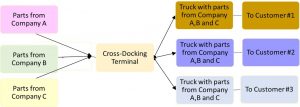
Note: From Kukhta, 2021. [Image Description]
In this type of warehouse, large bulk-packed quantities are split into smaller quantities and stored until transportation is required in a supply chain. The products are re-packaged and labelled before being shipped to their destination.
The APICS Dictionary defines break bulk as “dividing truckloads, railcars or containers of homogeneous items into smaller, more appropriate quantities for use” (as cited in APICS Coach, 2017, para. 3).
Hub-and-spoke warehouses are large and tend to be located at places where transportation systems converge. Think of the shape of a bicycle wheel. Hub-and-spoke systems consolidate products at a spoke (regional) warehouse, move them to a hub (central/national) warehouse, send them back out to a spoke warehouse, then distribute them.
End-to-point warehousing does not consolidate, nor store but sends products directly to their destination. Airlines tend to use this system for moving people. Passengers are collected at major airports like Chicago, Atlanta, Cincinnati, and Denver. The passengers then transfer to a different plane that files them to their destination.
In a point-to-point system, products move from any warehouse to another warehouse. In a hub-and-spoke system, products move to a central “hub” warehouse before being distributed to the next warehouse in the process. (Rodrigue, 2021).
Distribution centers are the last stop before a product is shipped to a wholesaler, retailer or to an end-user. Distribution centers tend to be located close to the market. Amazon calls these facilities “Fulfillment Centers”. They are located close to customers. This allows Amazon to shorten delivery times and support its “Amazon Prime” quick deliveries.
In Figure 5.10, the Distribution Centre/Fulfillment Centre there is typically a high variety of products that are ready to be delivered on short notice. They are located close to the end-use customer so that you can have short delivery times. A lot of inventory moves through these facilities and does not stay there for a long time.
Figure 5.7
Amazon Fulfillment Centre (also known as a Distribution Centre)

Note. From Scottish Government, 2011. :CC BY-NC 2.0
If the product’s destination is the manufacturing factory in the supply chain, storage will be required. The incoming materials will need to be stored before moving on to the next step in the manufacturing process.
If the product’s destination is the end-user, storage may not be necessary and the product may be used immediately. Different operational logistics are required to manage that type of inventory which is not covered in this text.
Figure 5.8 shows a factory’s internal storage and warehousing of lumber used to make doors (considered raw materials). This lumber was received through a logistics network that they manage and use to make their products. A finished goods warehouse or storage area would be the origin for the next step in the manufacturing and logistics processes.
Figure 5.8
Factory Internal Storage
 Note. From Lester Public Library, 2012. CC BY-NC-SA 2.0.
Note. From Lester Public Library, 2012. CC BY-NC-SA 2.0.
When vehicles arrive at a car dealership, they are unloaded and moved onto the lot.
Figure 5.9 shows a tractor-trailer that is designed for carrying cars to dealers.
Figure 5.9
Tractor Trailer Carrying Cars to a Dealership
Note. From Adams, 2015. CC BY-SA 2.0.
Their next step is to be received and prepared for sale as shown in this car lot. This image shows cars at a car dealership waiting to be purchased by customers. This storage lot is a destination warehouse.
Figure 5.10
Used Car Dealership
Note. From Lang, 2015. CC BY-SA 4.0.
Various types of equipment are used to move cargo to storage. At ports, large cranes, as shown in the figures below, are used to unload bulk cargo from ships. Heavy bulky items such as shipping containers, tree logs, and metal fabricated parts may require cranes to move them. There are various types of cranes depending on the crane’s location.
Figure 5.11 shows a large crane with large holding and clamping devices for loading and unloading shipping containers from ships to move to trucks, trains, or storage.
Figure 5.11
Port of Miami, Container Ship Yard
Note. From Kramer, 2009. CC BY 2.0.
Figure 5.12 shows a movable overhead crane with clamping devices designed for shipping containers placing a shipping container onto the bed of a truck. This image shows containers being exchanged, using a movable overhead crane with clamping devices designed for shipping containers, between trains and trucks in an intermodal yard.
Figure 5.12
Talleyrand Terminal Railroad

Note. From Jaxport, 2013. CC BY-NC 2.0.
Figure 5.13 shows large logs being moved by a crane at a sawmill onto a flatbed railway car. The jaws of the crane are specifically designed to handle logs and lumber.
Figure 5.13
Crane Loading Large Logs onto Railroad
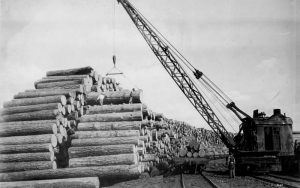
Note. From Forest History Society, 1925. CC BY- NC 2.0.
There are various types of cranes used at bulk ship terminals. Different types are based on their location and functionality: “bulk handing cranes can be positioned along the quay (quay crane), on a platform/pontoon (floating crane), or on the ship (deck crane)” (Notteboom, Pallis, & Rodrigue, 2021, para. 1).
Forklifts are used to load and unload trailers, move loads within the warehouse, move products, and skids in warehouses. Forklift trucks are rugged, can lift heavy and awkward objects to a wide range of heights and are very maneuverable. Specific licenses and certain are usually required to operate forklift trucks. They also have forks that fit into the skids used to hold products.
Figure 5.14 shows a forklift truck with its forks extended underneath the load. In this case, a picnic table has been picked up to be moved.
Figure 5.15 shows a diagram labelling the various parts of a standard forklift truck.
Figure 5.14
Forklift
Note. From Sproule, 2006. CC BY 2.0.
Figure 5.15
Note. From Tynt22, 2006. CC BY-SA 3.0 Unported license.
Other types of Material Handling Equipment (MHE) such as hand pallets trucks, rider pallet movers, reach trucks order pickers, and narrow aisle turret trucks may be used to move products in a warehouse.
Figure 5.16 shows a smaller, manual version of a forklift called a hand pallet truck or cart. It can slide underneath a skid, in this case, boxes of fruit, and be pumped up off the ground so that one person can move inventory in a warehouse. They are easy to use and very maneuverable which saves a lot of energy and effort that would be required to move them manually.
Figure 5.16
Versatile Manual Forklifts
Note. From Toyota Material Handling EU, 2011. CC BY-NC-ND 2.0.
Figure 5.17 shows a warehouse worker moving storage bins used to house products. For many products, at some point in the process, products are moved manually.
Figure 5.17
 Note. From Desjardines, 2012. CC BY 2.0.
Note. From Desjardines, 2012. CC BY 2.0.
A warehouse audit can be defined as “a general term that applies to thoroughly assess and monitoring any operation in a warehouse. Some of these audits include inventory, policies, and procedures” (APS Fulfillment, 2020, para .1). The inventory in warehouses is checked for accuracy against documentation created about that inventory. This can be done in a variety of ways, including complete counts and cycle counts.
Complete counts of the inventory are often called wall-to-wall inventory checks. This is done when a warehouse is shut down from shipping and receiving. Another method is to cycle count. With this method, smaller subsets of the inventory are periodically checked by auditing samples rather than entirely counting every product. Products are assigned audit or cycle-counting frequencies depending on their value, importance, and volumes used.
These audits and inventory checks are done to verify what your actual inventory is. Discrepancies can happen. Discrepancies between what is counted to what the documentation shows are investigated and resolved. Inventory can get lost, stolen, wrongly moved, sent to the wrong place, mislabeled, or hidden. This can lead to stock-outs (running out of stock) or too much stock resulting in extra costs.
An interactive H5P element has been excluded from this version of the text. You can view it online here:
https://ecampusontario.pressbooks.pub/logistics001oerfc/?p=57#h5p-10
Figure 5.18 shows a failure in packaging and handling. What has happened to the product in this box? Is it still intact and safe? The goal of successful warehouse storage focuses on safely storing and handling products so that all of it is accounted for and it can leave for its next destination safely.
Your work and time spent designing and planning for the safe storage of your products as they travel to their destination can be wasted if the product gets damaged or lost on the way or while it is stored. You are already a warehouse manager: your refrigerator at home is a small warehouse where you fill it with food, retrieve and use food and maintain safe storage of your food
Figure 5.18
Failure in Package Delivery
 Note. From Forsaken Fotos, 2016. CC BY 2.0.
Note. From Forsaken Fotos, 2016. CC BY 2.0.
In this chapter, we have considered the role that warehousing/storage contributes to the supply chain process. We have discussed the uses of different types of warehouses, examined the role of warehouses and distribution centers in a supply chain, and described common types of equipment used to load and unload products at warehouses. The type of warehouse used plays an important role in an efficient supply chain.
Adams. (May 15, 2015). Renault 380 car carrier. [Photograph]. Flickr. https://www.flickr.com/photos/satransport/17688579282. Licensed for reuse under CC BY-SA 2.0.
Amazon FC Tours. (2021, April 10). Amazon Fulfillment Center Video Tour. YouTube. https://youtu.be/UAKPoAn2cB0
APICS Coach (2017, November) Break bulk warehouse. APICS Coach. https://apicsdotcoach.wordpress.com/2017/11/12/break-bulk-warehouse/
Cole International. (2016, September 21). Consolidation and cross-docking: Two methods for improving shipping efficiency. Cole Blog – Cole International. https://blog.coleintl.com/blog/consolidation-and-cross-docking
DatalogicAccuSort [username]. (2013, February 7). Cross-docking: Receiving dock direct to shipping dock [Video]. YouTube. https://youtu.be/OS5CrureJoE
Desjardines, V. (2012, April 5). France : Normandie, Seine-Maritime (76), Le Tréport : poissonnerie municipale, 7h43 [Photograph]. Flickr. https://www.flickr.com/photos/endymion120/6974239386/in/photolist-edNUUn-9DiJK9-f7h28E-9JEzQg-d6RAR1-5eMUPZ-7MGPiB-7EATqz-BbTo6v-gnhiQp-bgKdep-KwD9Mb-a6Dp1W-CUquZM-9yNhdc-cyAdz9-9K1WsV-d36iZY-DgoFWJ-6chCJJ-cFsT5y-edUApA-f7h5ob-BheMZh-sxdNLa-9Cnmvp-5j9w7a-9RvMch-abCnxX-BhpnpW-8Qwc9f-NczRMF-sfbQgu-pew1Sf-p5wiZ-9qhrGJ-hFTdVG-xHMvjq-9o62Zm-asyf8y-bChNoE-74Xvok-ndLdCJ-9rsjNn-CEwHDj-owqC77-7L4i69-9aT8AT-6C15Q4-JDxf1Q. Cropped. Adapted for reuse under CC BY 2.0.
Forest History Society. (1925). Crane loading large logs onto railroad. [Photograph]. Flickr. https://www.flickr.com/photos/foresthistory/4926794351. CC BY- NC 2.0.
Forsaken Fotos. (2016). UPS delivery epic fail. [Photograph]. Flickr. https://www.flickr.com/photos/55229469@N07/29489605404. Licensed for reuse under CC BY 2.0.
Ian BC North. (2006). Trucks at Huckleberry mine.[Photograph]. Flickr. https://www.flickr.com/photos/91997797@N00/329792944/in/photolist-v9gXf-TSgYE7-MteLXk-7k7DiU-wnkr5-VjUnSX-NbbsB5-5yeCPH-T8wXkh-95h31u-5yj1UE-9LJY37-5vUGRc-8ksE6t-kJ5Fvq-65SjPv-Dpmjr8-pNb8w-7Uh6Hp-PSd5YS-6Z8JcB-GVzqEk-kVzH8P-2VrdjR-9jaWwc-dMnddX-Ha2GX5-ohThsg-9Tui74-gWAr8Q-P7TPrq-zjDeWk-i5fR7-9LGHxt-AHf7n3-adKiH4-9LKbdu-7Uksmb-azMsXn-2brB1QN-26X9cCj-cYy2Jb-cYya4J-9LKwk1-cvA57h-AUGm3g-746EMr-eyjfDH-JfzJga-9LGy1e. Licensed for reuse under CC BY-NC 2.0.
Jaxport. (2013). First shipment of Volkswagens arrive at Blount Island. [Photograph]. Flickr. https://www.flickr.com/photos/jaxport/17104977627/in/photolist-s4vtVn-GoxtWT-rqQnNd-pTeZ7K-8RMn6S-wjwpKS-rr2EDK-s6odxH-ioei3X-NcowZe-iodzw2-iodAYF-t2ty9g-416Ez1-Uours4-pE6mrX-rksGFE-efpcj4-8RJf9e-efpdX4-8RMmHo-8RJfdz-g4Z8sZ-2a1LPz6-7YYT8y-pAUPRE-8RJf6v-8RMnkh-416HYj-CpJyyA-L6eeo7-ajvLfY-416PA9-LcCFiA-ajvKQh-p8V22-hF5uT4-a49aKi-28opnAw-7YYnQ3-2joYoPc-2m93g9b-2m8X42X-xuhJT-2md8VAu-2mtGc8Q-2iN5qpp-2kZWsPZ-2kZZkyw-5DeXwG. Licensed for reuse under CC BY-NS 2.0.
Jaxport. (2013). Talleyrand terminal railroad. [Photograph]. Flickr. https://www.flickr.com/photos/jaxport/8634966179. Licensed for reuse under CC BY-NC 2.0.
Kramer. (2009). Port of Miami, Container Ship Yard.[Photograph]. Wikimedia Commons. https://commons.wikimedia.org/wiki/File:Port_of_Miami_container_ship_yard.jpg. Licensed for reuse under CC BY 2.0.
Lang. (2015). Used Car Dealership. [Photograph]. Wikimedia Commons. https://commons.wikimedia.org/wiki/File:Car_Dealer.jpg. Licensed for reuse under CC BY-SA 4.0.
Lester Public Library. (2012). First Floor Cutting Room. [Photograph]. Flickr. https://www.flickr.com/photos/lesterpubliclibrary/7985523567/in/photolist-daDTWP-7FQ3d2-6eC6AD-6eGeiu-d7uj4L-dma4VS-82H8x2-82LeZ3-94mNBY-wFrYrx-pZ5AwJ-94mMtJ-dma5zo-7MjCaA-eGKsy-9Zfuow-daEsp7-94mMxN-9diGTp-g4thPJ-dma2d8-82GYqT-9U2veX-2kxrb4J-2fXUbhK-ZMnGe3-qNGAGn-SqBxKs-2iZqv3x-2hUj1RM-2iRM5rd-2iZqqaS-CimJBq-23q7Jcv-2j6hukV-BUqfv2-2j39yF7-2j6fYva-2iZuMQ6-2i2hfXd-2hUj1Hf-2i5s488-2hHFcNA-2i8PWJK-2iZt6Q7-2j6dkbg-2iZHABT-oJ6tU4-2hUj1Fb-2hLkCbb. Licensed for reuse under CC BY-NC-SA 2.0.
McKibben, K. (2017, February 3). What is cross-docking? [Video]. YouTube. https://youtu.be/N2lnL9uHyNY
Millennium Luxury Coaches. (2010). Parts room. [Photograph]. Flickr. https://www.flickr.com/photos/millenniumluxurycoaches/5288861748/in/p. Licensed for reuse under CC BY-NC-SA 2.0.
Notteboom, T., Pallis, A. & Rodrigue, J.P. (2021). Crane technology and bulk terminals. Port Economics, Management and Policy. https://porteconomicsmanagement.org/pemp/contents/part3/bulk-breakbulk-terminal-design-equipment/crane-technology-at-bulk-terminals/
Phil’s. (2011). Pony Delivery- Canyon Park Ford. [Photograph]. Flickr. https://www.flickr.com/photos/1stpix_diecast_dioramas/6519504529. Licensed for reuse under CC BY-NC-SA 2.0.
Rodrigue, J.P. (2021). Point-to-point versus hub-and-spoke networks. The Geography of Transport Systems. https://transportgeography.org/contents/chapter2/geography-of-transportation-networks/point-to-point-versus-hub-and-spoke-network/
Sproule, R. (2006, September 1). Forklift [Photograph]. Flickr. https://www.flickr.com/photos/robbie1/238070488/in/photolist-n3b4A-6V9XCy-6V9Xt9-6V9Xfw-o79s8-o79rz-o79rn. Licensed for reuse under CC BY 2.0.
Sunol, H. (2021, March 14). Consolidation warehouse – Its meaning, benefits, and drawbacks. Cyzerg Warehouse Technology. https://articles.cyzerg.com/consolidation-warehouse-meaning-benefits-and-drawbacks
Toyota Material Handling EU. (2011). BT Lifter Hand Pallet Trucks. [Photograph]. Flickr. https://www.flickr.com/photos/toyotamheurope/6323175476. Licensed for reuse under CC BY-NC-ND 2.0.
Tynt22. (2006, July 8). Forklift [computer-generated diagram]. Wikimedia Commons. https://commons.wikimedia.org/wiki/File:Forklift_Truck.jpg. Licensed for reuse under CC BY-SA 3.0.
Figure 5.1 This figure shows a generic product supply chain flowchart: Raw materials selection then logistics (movement and storage, warehouses and bulk storage), then manufacture stage, then logistics (movement and storage, distribution centres and warehouses), to retail stores and/or consumers, then to product end use. [Back to Figure]
Figure 5.3: This figure shows different types of warehouses at different points in the supply chain. From left to right, there is before logistics, logistics and after logistics.
Figure 5.6: This figure shows a cross-docking warehouse. From left to right, there is suppliers bring products to the cross-docking terminal where it is moved to customer trucks to be transported to customers
Logistics services range from a 1PL – level one logistics provider to a 6PL – sixth level service provider. This chapter will focus on the most common type of Logistic Service Providers, namely, 1PLs to 4PLs, and their roles and functions.
An interactive H5P element has been excluded from this version of the text. You can view it online here:
https://ecampusontario.pressbooks.pub/logistics001oerfc/?p=60#h5p-11
A common term used in logistics when describing a logistics service provider is 3PL (third-party logistics). Unfortunately, many companies call themselves 3PLs but may not offer the services expected by a 3PL service provider. In an attempt to reduce confusion around the terminology, legislation was passed in 2008 which legally defined a 3PL as “a person who solely receives, holds, or otherwise transports a consumer product in the ordinary course of business but who does not take title to the product” (Vitasek, 2013).
The Council of Supply Chain Management Professionals further explains 3PL (2013) as the following: “[o]utsourcing of all or much of a company’s logistics operations to a specialized company.” Furthermore, the term “3PL” was first used in the early 1970s to identify intermodal marketing companies (IMCs) in transportation contracts. Up to that point, contracts for transportation had featured only two parties, the shipper and the carrier. When IMCs entered the picture—as intermediaries that accepted shipments from the shippers and tendered them to the rail carriers—they became the third party to the contract, the 3PL. (Vitasek, 2013).
To understand the form and function of a 3PL, one needs to understand the different layers of logistics services and the supply chain integration at each level.
The most basic level of a logistics service provider is the 1PL. A 1PL model is a simple arrangement where the manufacturing company utilizes its own internal resources to ship goods to a consignee (recipient of the goods being shipped). All the supply chain functions from order acceptance, manufacturing the goods, and shipping the goods are managed and completed by the consignor (company shipping the products). The trucks and labour used in the delivery process are resources of the consignor. An example of a 1PL is a farm delivering its products to a local store for sale.
Once an organization decides to outsource the transportation component of the supply chain (i.e., trucking), it often turns to the services of a 2PL service provider. The 2PL service provider often specializes in a mode of transportation. It could specialize in over-the-road trucking, ocean transportation, or one of the other modes of transportation. The 2PL does not integrate into the consignor’s supply chain, nor does it provide logistics planning or solutions. It simply moves the freight as specified by the consignor to the consignee. The 2PL manages the assets and labour required to move the freight. Often the shipping company will have a contractor with the transportation company, or the freight could be moved on an as-needed basis. FedEx is an excellent example of a 2PL provider.
Once a company decides that it is time to outsource logistics functions to a 3PL, it requires more than a delivery company. 3PL providers offer supply chain integration, warehousing, possibly customs clearing services, or expertise in more than one mode of transportation. To be a 3PL, one does not need to offer all of the supply chain functions, but it does need to manage the delivery elements on behalf of the customer. An important distinction between a 2PL and a 3PL is that a 3PL executes and manages the delivery function of the supply chain. Even though the 3PL does not design the supply chain on behalf of a customer, it does manage all the delivery-related supply chain elements. A 3PL will offer one or more of the following supply chain functions:
According to Vitasek (2013), a 4PL (fourth-party logistics) differs from a 3PL in four ways:
Essentially a 4PL, or Lead Logistics Provider (Vitasek, 2013), works with a customer to design and manage their entire supply chain. The Lead Logistics Provider (LLP) will work with the customer to establish which routes should be Full Truck Loads (FTL), Less than Truck Loads (LTL), the pick-up frequency, decide on optimal warehouse locations, and aid in the negotiation of transportation rates and warehousing rates. A fully integrated LLP will have the following expertise and personnel:
IIPMR’s video, Difference between 1PL, 2PL, 3PL, 4PL and 5PL Logistics Providers, provides a great recap of the type of service providers and their functions. This video also includes a definition of 5PL, which was not discussed in this chapter.
An interactive H5P element has been excluded from this version of the text. You can view it online here:
https://ecampusontario.pressbooks.pub/logistics001oerfc/?p=60#h5p-12
IIPMR. (2020, October 10). Difference between 1PL, 2PL, 3PL, 4PL and 5PL logistics providers [Video]. YouTube. https://www.youtube.com/watch?v=2X6rD1nJx4M.
Vitasek, K. (2013, August). Supply chain management terms and glossary. Council of Supply Chain Management Professionals. https://cscmp.org/CSCMP/Academia/SCM_Definitions_and_Glossary_of_Terms/CSCMP/Educate/SCM_Definitions_and_Glossary_of_Terms.aspx?hkey=60879588-f65f-4ab5-8c4b-6878815ef921
The Covid-19 pandemic has caused havoc in many global supply chains. Microprocessor shortages stopped auto manufacturing, shipping container shortages delayed delivery, the rising cost of shipping rates is eroding the cost advantage of international trade. Is it time to move away from global suppliers and form new nearshore relationships?
UPS. (2018). UPS global freight forwarding. [Video]. YouTube. https://www.youtube.com/watch?v=x_VF8EZpsXE.
An interactive H5P element has been excluded from this version of the text. You can view it online here:
https://ecampusontario.pressbooks.pub/logistics001oerfc/?p=64#h5p-13
Global transportation is a complex and integral facet of an effective global supply chain. When we think of global transportation, it is essential to consider it as a whole system rather than only the individual mode. An effective global transportation strategy depends on how well the processes integrate. The transportation strategy formulation begins during the purchasing phase and ends when the goods are delivered.
Global supply chain involves dealing with suppliers in foreign lands, complying with the laws of the land, navigating the duties and customs regulations and finally arranging the transportation of the goods to the delivery point. The process can be confusing, and obtaining transparency in the supply chain is very challenging.
The first step in global transportation management is mapping out the total cost and understanding the total landed cost of the goods. The cost mapping process needs to consider the cost of the goods, international and domestic duties, tariffs and customs-related expenses, transportation costs to the port of export, transportation costs of the international transportation, transportation costs from the port of import and transportation costs to the delivery point.
In addition to the costs of physically moving the freight, the transactional cost of paperwork, duties and tariffs must be included in the landed cost. Having a transactional cost category that captures items such as the terms of trade, terms of payment and cargo insurance is an important element in determining the total landed cost.
Terms of trade are vital because they define when the ownership of the goods pass from the seller to the buyer, which party is responsible for the transportation and where the exporters’ responsibilities end and the importers’ begin. A universally accepted resource to aid parties involved in global trade is the International Chamber of Commerce(ICC). ICC developed a defined list of trade terms referred to as Incoterms. As defined by The Supply Chain Management Terms, INCOTERMS are “international terms of sale developed by the International Chamber of Commerce to define sellers’ and buyers’ responsibilities.” Incoterms rules “ explain eleven of the most commonly-used three-letter trade terms which reflect contract language for business agreements ”(ICC,2021)
Each mode of transportation has a subset of incoterms specific to that mode. For example, FAS, FOB, CFR, CIF apply only to ocean freight. The intent of this resource is not to provide an exhaustive course in understanding how to use Incoterms but rather to introduce the student to the existence of Incoterms and provide an introduction to them. The International Chamber of Commerce offers several tools for learning more about how and when to use incoterms.
Think of Incoterms as a resource to describe:
Note, Incoterms are not a substitute for a contract of sale. They are to be used within the context of a sales contract and provide a generally accepted vocabulary. Incoterms have been revised several times, and as such, the revision year needs to be referenced within the incoterm. The revision year needs to be clearly stated in the contract language. For example, if we used FOB in a contract, it would look like “ FOB (Vanterm, Vancouver) Incoterms 2020”.
Although Incoterms define when the risk transfers from the seller to the buyer, they do not ensure that the seller will receive payment for the goods, nor do they ensure that the goods will be received in good quality by the buyer. In global trade, the risk of non-payment is real. If a seller extends credit to a foreign buyer and ships a product that will be paid by the buyer when received, this arrangement introduces the risk of non-payment for the supplier. Suppose the seller demands payment for the goods before shipping them. In that case, the buyer risks paying for a product in advance of inspecting the product and receiving a substandard product or, worse, not receiving a product at all. Using the services of an escrow agent aids in mitigating the risk of non-payment and the risk of product non-delivery. A letter of credit (LC) is one form of escrow facilitated by a bank. The bank will guarantee payment from the importer to the exporter provided that the terms of the letter of credit are satisfied. The use of an LC is beneficial because it clearly outlines the conditions of payment and it defines the product specifications that must be met. It protects both the exporter and the importer.
Depending on the value of the goods, mitigating the risk of loss or damage is a good business practice. Finding cargo insurance for international freight is challenging due to the transportation risk and the introduction of jettison, overboard cargo, water damage and a host of transportation perils. Due to the complex nature of international cargo insurance, the specific terminology and differing regulations in international regions engaging an organization’s expertise in international trade is imperative. Knowledge of the Carriage of Goods by Sea Act needs to be discussed and understood during the planning phase of global transportation.
The Second Step in Global Transportation is determining the actual method of transportation. When considering global transportation, ocean and air freight are the two predominant modes. However, many times global transportation involves three modes of transportation. Namely, truck, ocean and rail. When more than one mode of transportation is required, it will be defined as a multi-modal or an intermodal move.
Both multi-modal and intermodal moves involve utilizing two or more modes of transportation. For example, the transportation moves could entail a truck and an ocean carrier or truck, ocean and rail. The combination of the various modes does not define a multi-modal or intermodal move; instead, the structure of the contract defines the move. In multi-modal moves, the consignee enters into one contract with the consignor. The consignor arranges all the transportation regardless of the number of modes of transportation required to complete the delivery. In an intermodal move, the consignee will enter into a contract with the service provider for each mode of transportation. The consignee could have up to five separate contracts for one shipment.
When determining mode selection, the criterion will revolve around capacity, transit time, accessibility and reliability. Accessibility is dependent on the region’s access to ports, airports, railways, pipelines and highways. Not every area has access to every mode.
Processes and systems need to be validated and tested to ensure that a company’s global logistics strategy is successful. Integration with offshore suppliers’ systems and validating the ability to receive timely Advance Ship Notices (ASN) improve the communication between exporter and importer. The Importer’s Transportation Management System (TMS) should be able to model multi-modal inbound and reverse logistic routes. Mapping the Domestic and international workflow is imperative, and often, at this stage, many companies discover an expertise gap that may exist in one or more of the essential processes. Identifying gaps and establishing strategies or partnerships to address the shortfalls occur during this step in the global logistics validation mapping process. Custom brokerage integration and carrier selection for both international and domestic routes will be completed, and contracts prepared.
A critical link in global transportation is establishing a robust financial settlement process. Payment terms will be decided during step one of the process; however, the execution of the payment process must be mastered so that the flow of material is not interrupted by payment-related issues or missing documentation.
Finally, after all the planning, mapping, validating, and testing of the global infrastructure, contracts will be prepared, and the strategy will be implemented. Even the best-planned plans will have operational challenges. Transportation delays, inclement weather, and supplier shortages test the expertise and problem-solving ability of the transportation management team.
When reviewing global logistics, the dominant mode of transportation is ocean shipping. According to the International Chamber of Shipping (ICS), the international shipping industry accounts for 90% of all world trade. Based on the statistics from Infomaritime, the country controlling the largest fleet of ships is Greece with 17.6% of the world’s ships.
An interactive H5P element has been excluded from this version of the text. You can view it online here:
https://ecampusontario.pressbooks.pub/logistics001oerfc/?p=64#h5p-14
CNBC. (2021). What’s causing the container ship traffic jam clogging up global trade [YouTube]. https://www.youtube.com/watch?v=E7t5yj1rScI&t=56s.
International Chamber Of Commerce. (2021, June 22). INCOTERMS® 2020 – ICC – International Chamber of Commerce. ICC. https://iccwbo.org/resources-for-business/incoterms-rules/incoterms-2020/
Roberts. (2021, September 3). World’s merchant fleet in graphs. Infomaritime.eu. http://infomaritime.eu/index.php/2021/09/03/where-is-registered-and-who-owns-worlds-merchant-fleet/
In logistics, transportation is governed by a body of regulations, and each jurisdiction, whether provincial, federal or by country, may have different transportation-related regulations. However, generally speaking, the trucking, rail, air, and ocean modes of transportation are more similar than different. Nonetheless, it is imperative to review and check with the regulator body before moving freight into another province, state, or country. In this chapter, a framework of the rules for transportation is provided. Be mindful that laws evolve, and key takeaways from this chapter are discovering where to look for updates and confirming your understanding of the regulations.
An interactive H5P element has been excluded from this version of the text. You can view it online here:
https://ecampusontario.pressbooks.pub/logistics001oerfc/?p=66#h5p-15
Each mode of transportation has a governing body that establishes rules and regulations for operating a commercial vehicle, vessel, airplane, or locomotive. In Canada, each province has specific regulations, and as such, the local governing body needs to be consulted before operating a commercial vehicle within each region. For example, trucking in Ontario is regulated by the Ministry of Transportation. At the federal level, transport is regulated by Transport Canada. In the United States of America, the Department of Transportation is the federal regulatory body. It is noteworthy that a Canadian transport operator must comply with the regulations in the specific region they are driving within even though their commercial license was granted in another jurisdiction. If the international regulation is more lenient than the Canadian standard, the driver must adhere to the stricter regulation. For example, suppose the permitted service hours are 14 in the USA and 12 in Canada. In that case, the Canadian driver must comply with the 12 hours if they pass through any Canadian province during their delivery. The same goes for an American driver when driving in Canada. Even though the permitted hours of service are longer in the USA, the American driver must comply with the Canadian regulations when driving in Canada.
Regulations govern vehicle safety, operating weight limits, licensing, service hours, and compliance. The following excerpts from the Commercial Vehicle Drivers Hours of Service Regulations, SOR/2005-313 outline the driving hours permitted for operating commercial vehicles.
Scheduling — Driving South of Latitude 60°N
Application
11 Sections 12 to 29 apply in respect of driving south of latitude 60°N.
Daily Driving and On-duty Time
Mandatory Off-duty Time
Daily Off-duty Time
[15 reserved]
Splitting of Daily Off-duty Time — Single Driver
As you can see, the driving regulations can be confusing. Fortunately, trucking operations must have a compliance/safety officer who reviews drivers’ schedules and logbooks to ensure drivers comply with the stated rules and regulations. The Ministry of Transportation also has MTO officers that will audit drivers’ logbooks, and any found that do not adhere to the standard will result in penalties for the driver and the related trucking company.
Smart Drive Test. (2016, February 7). Log books | Canadian rules [Video]. YouTube. https://www.youtube.com/watch?v=Kzu7H95TdBw&t=62s.
All trucks and trailer configurations have weight limits based on the vehicle’s axle configuration.
Regulations exist that stipulate the weight limitations of a truck. The weight limit is based upon several factors, such as axle configuration and truck length. However, the weight limit and truck configuration are province-dependent. In 2010, Ontario introduced a four-phase change to the vehicle weight and dimension regulation. The Highway Traffic Act, Part VII: Load and Dimensions prescribes Ontario’s vehicle weight and dimension limits. These regulations are administered by the Ministry of Transportation, Ontario (MTO).
The reform is designed to protect the infrastructure of Ontario’s highways, bridges, and pavement from excessive wear. The reform introduces a two-tier system of vehicle weights and dimensions. One tier is the safe, productive, infrastructure-friendly (SPIF) vehicles and non-SPIF vehicles. The maximum truck length SPIF vehicles. The change requires SPIF vehicles to be equipped with self-steering axles and load-equalized axles. According to the MTO guide to vehicle weights after December 2020, all commercial vehicles must be SPIF compliant, and all grandfathering exceptions will expire (Highway Traffic Act, 2021).
It is important to note that the regulation should be consulted before any fleet decisions are made. Currently, the industry standard for a five-axle 53-foot truck and trailer configuration is a gross vehicle weight of 80,000 lbs. The video below explains this further.
Armor Freight Services. (2019, October 24). Commercial vehicle weight limit [Video]. YouTube. https://www.youtube.com/watch?v=81fawkRb3io.
Read the updates and changes to regulations on weights and dimensions for SPIF vehicles in Ontario.
In Canada, the aviation sector is governed at the federal level. Licences, permits and certificates, piloting, ownership requirements, aircraft registration, and passenger right are governed by the following legislation:
Compliance with these regulations has the following considerations. Shipments are only acceptable for transportation when the shipper, consignee, or owner has complied with the rules and regulations of the tariffs and all laws, ordinances, and other governmental rules and regulations governing the transportation of the shipment. Each country has specific air cargo packaging, security, and customs requirements. Often freight forwarders have expertise in each region and ensure compliance with the regulations. The Canada Transportation ACT (CTA) is responsible for monitoring Canada’s air carriers’ compliance. The CTA can conduct investigations, impose administrative monetary penalties and suspend or revoke licenses.
IATAtv. (2020, September 20). What’s new in the 2021 IATA Special Cargo Regulations? [Video]. YouTube. https://www.youtube.com/watch?v=l84kya94LMQ
Transport Canada is primarily responsible for enforcing rail safety regulations (Railway Safety Act (R.S.C., 1985, c. 32 (4th Supp.))) and conducting research and development to improve railroad safety. The Federal Railroad Administration (FRA) promotes safe, environmentally sound, successful railroad transportation in the USA.
Review the various sections of the Government of Canada Rail Transportation guidelines that pertain to freight, shipping, safety, and more.
Rules, rules, and more rules. The key takeaways from this chapter are that companies moving freight anywhere in the world must adhere to the latest regulations set by the governing regulatory organization, and it is essential to keep current with the latest legislation.
An interactive H5P element has been excluded from this version of the text. You can view it online here:
https://ecampusontario.pressbooks.pub/logistics001oerfc/?p=66#h5p-16
Aeronautics Act. RSC 1985, c A-2. https://laws-lois.justice.gc.ca/eng/acts/c-10.4/
Armor Freight Services. (2019, October 24). Commercial vehicle weight limit [Video]. YouTube. https://www.youtube.com/watch?v=81fawkRb3io.
Canada Transport Act. SC 1996, c 10. https://laws-lois.justice.gc.ca/eng/acts/c-10.4/
Carriage by Air Act. RSC 1985, c C-26. https://laws-lois.justice.gc.ca/eng/acts/c-26/index.html
Commercial Vehicle Drivers Hours of Service Regulations, SOR/05-313. https://laws-lois.justice.gc.ca/eng/regulations/SOR-2005-313/FullText.html
Highway Traffic Act. RSO 1990, c H.8. https://www.ontario.ca/laws/statute/90h08#top
IATAtv. (2020, September 20). What’s new in the 2021 IATA Special Cargo Regulations? [Video]. YouTube. https://www.youtube.com/watch?v=l84kya94LMQ
Railway Safety Act. RSC 1985, c 32 (4th Supp.). https://laws-lois.justice.gc.ca/eng/acts/r-4.2/
Smart Drive Test. (2016, February 7). Log books | Canadian rules [Video]. YouTube. https://www.youtube.com/watch?v=Kzu7H95TdBw&t=62s.
Transport Canada. (2021, November 22). Motor carriers, commercial vehicles and drivers. Government of Canada. https://tc.canada.ca/en/road-transportation/motor-vehicle-safety/motor-carriers-commercial-vehicles-drivers
Transport Canada. (2020, March 24). Rail transportation. Government of Canada. https://tc.canada.ca/en/rail-transportation
Vehicle Weights and Dimensions – For Safe, Productive and Infrastructure-Friendly Vehicles. O. Reg. 413/05. https://www.ontario.ca/laws/regulation/050413
It is unlikely that you will have to plan for logistics disruptions due to Godzilla as depicted in Figure 9.1. However, disruptions and delays to transportation and storage issues may have a similar impact. Logistics in a supply chain face many risks and challenges and Just when you think it is safe to ship your goods, unexpected situations or events can disrupt those plans. It is crucial to identify potential risks in a supply chain and create plans to mitigate the impact of these risks. Preparing in advance to identify risks and challenges to moving and storing products is part of logistics management in a supply chain. In this chapter, we identify current risks and challenges, explore potential risks and future challenges, and develop risk management strategies for assessing major risks and challenges in a supply chain.
Figure 9.1
Godzilla Playing with Trains in Godzilla 1985

Note. From Simpson, 2019. CC BY-NC 2.0.
An interactive H5P element has been excluded from this version of the text. You can view it online here:
https://ecampusontario.pressbooks.pub/logistics001oerfc/?p=68#h5p-18
Risks in a supply chain can range from road infrastructure, climate change, theft, damage to property, environmental damage, world events, poor inventory management, and delays in transportation to name a few. How often are stolen items never recovered, unlike this example in St. Thomas Ontario where a rash of trailer thefts carrying items like Steel was recovered totalling $1.5 million (Juha, 2021). While insurance coverage deals with the costs of issues after an incident has happened, it doesn’t deal with the challenges of the lack of materials or products needed at the moment. It is better to plan to avoid risk as much as possible and be prepared to dynamically manage situations as they unfold to minimize the damage caused. The first step in preparing to mitigate risks is to identify potential risks and challenges before they happen.
Supply chains and their logistics networks rely on safety stock (extra stock kept at locations in the logistics network) to compensate for interruptions in product flow. There are competing interests for determining the best amount of inventory at the right places in the supply chain. For example:
The following excerpt from an article titled “The Impact of COVID-19 on Logistics” published by the International Finance Corporation discusses how logistics have been affected by the pandemic and how economies in the world have been and will be affected by the massive disruptions that have occurred:
“The pandemic spread to the rest of the world, leading to lockdowns and border closures that restricted the movement of goods. Additional protocols (such as social distancing at warehouses) introduced to ensure the safety of workers contributed to bottlenecks for freight. For example, in the European Union, trucks formed 37-mile-long lines on the A4 highway after Poland closed its border with Germany in mid-March. In India, the lockdown created a shortage of truck drivers, which resulted in over 50,000 containers piling up in the ports of Chennai, Kamajarar, and Kattupalli.” (International Finance Corporation, 2020, p. 2)
Infrastructure refers to the road, rail, and water transportation used in the supply chain. This includes docks, harbours, bridges, shipping docks, and the systems used to design, build, and manage them. These transportation networks are significantly developed in some areas and very rugged and underdeveloped in other areas. Logistics decisions must consider the quality and reliability of the transportation infrastructure where the materials and products will travel and be delivered to.
Figure 9.2 shows a truck that crashed into a bridge that was too low for it to pass under. Consider these questions when preparing to mitigate risks in the future. What was the cause? Who planned this route? Was there a mechanical failure? Was the diver trained? What actions could be put into place to prevent this from happening again?
Figure 9.2
Trucker Memes
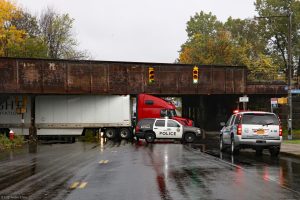
Note. From Swire, 2017. CC BY-NC 2.0.
Climate change has many impacts on supply chain logistics. More severe and different types of storms, heatwaves, economic instability, and population migration are just a few examples of impacts resulting from climate change. Extreme flooding in British Columbia in November 2021 after a summer of wildfires is thought to be the result of slow responses to climate change which led to gas rationing as pipelines between Alberta and British Columbia were impacted (Smart, 2021)
Figure 9.3 shows a marina with docks that should be floating but now sit on dry land. Droughts have lowered the water level in the lake. There is not enough water for the boats to dock and the marina to function correctly.
Figure 9.3
A Picture Demonstrating Drought Conditions in California at Lake Oroville
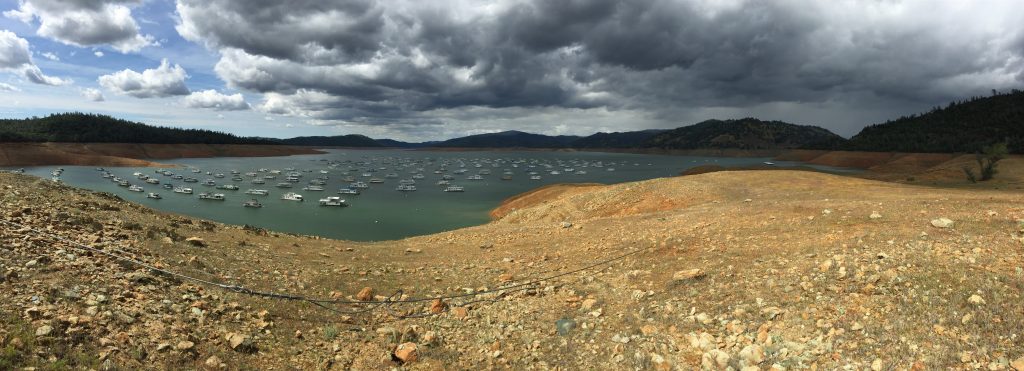
Note. From ray_explores, 2015. CC BY 2.0.
Snowstorms and blizzards can have a widespread effect on logistics. As Boudette and Eavies (2021) describe a significant winter storm that swept across much of the USA, “[p]ower outages, natural gas shortages and icy conditions made it hard for automakers, retailers and delivery carriers to operate across much of the South and Midwest. The winter storm […] severely disrupted businesses including large car factories, retail chains and the delivery services that people are deeply reliant on for basic necessities.” In Texas, the electrical grid was knocked out. FedEx noted disruptions because of travel hazards caused by the weather (paras. 1, 4, 13). These are just some of the impacts snow and ice can have. Can you think of any related risks you might need to consider if shipping items up to northern Canada?
Figure 9.5
Truck Stuck in the Snow
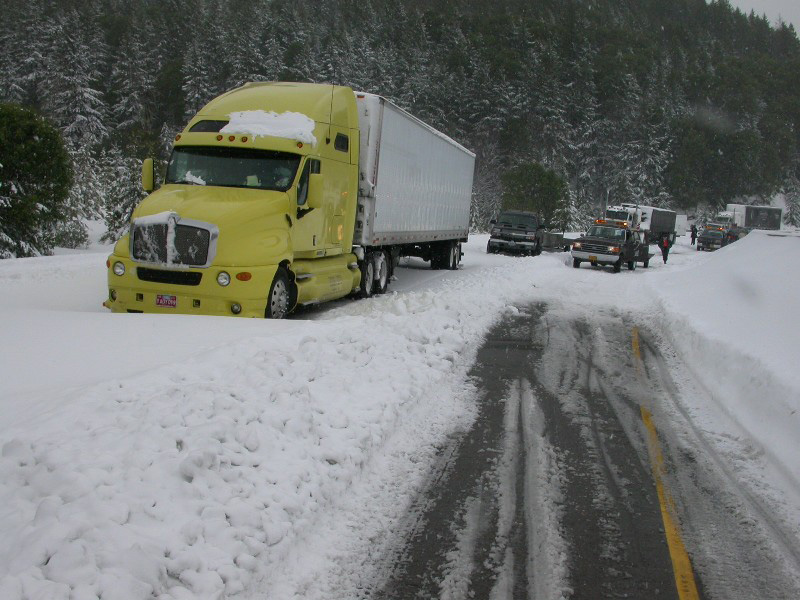
Note. From Oregon Department of Transportation, 2004. CC BY 2.0.
Wildfires can cause disruptions in supply chains. Routes may get cut off, warehouses might not be accessible or entirely destroyed. This will result in changes to transportation routes and where inventory is stored. Kaplan (2021) describes the impact that the wildfires in California have had on the logistics network: “[w]ith wildfire risks, some companies are considering moving warehousing operations or sourcing from vendors outside of potential fire danger areas” (para. 12).
Figure 9.6
Roads and Wildfires
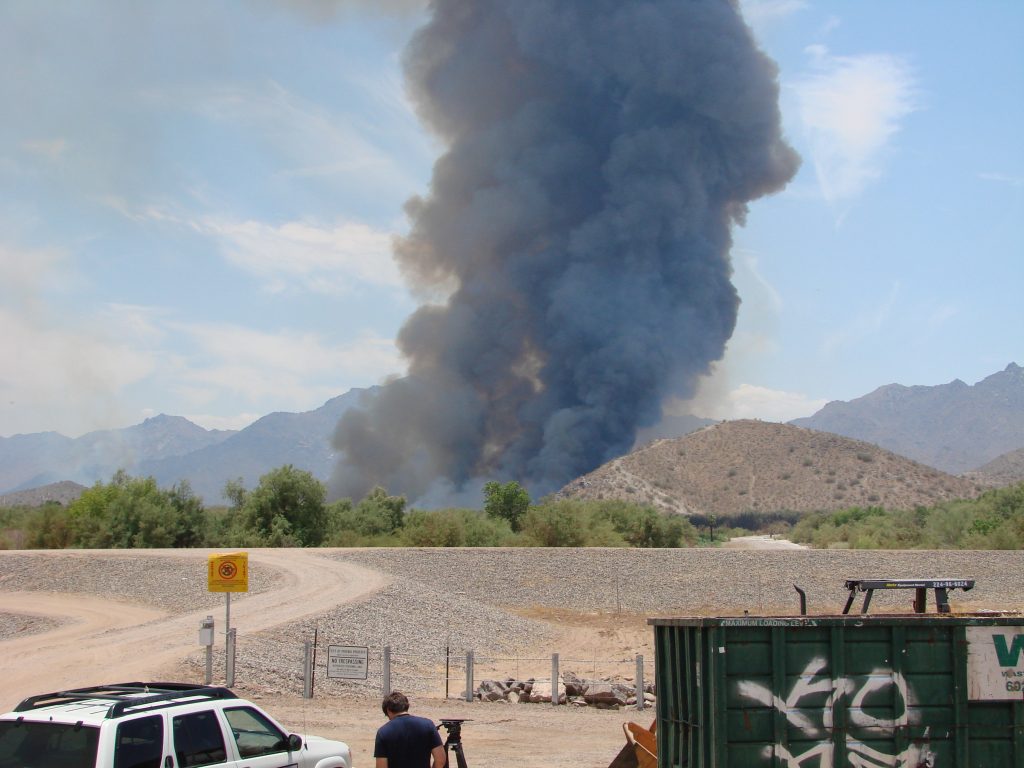 Note. From Spencer, 2008. CC BY-NC 2.0.
Note. From Spencer, 2008. CC BY-NC 2.0.
The Exxon Valdez accident in 1989 led to a massive oil spill that severely damaged the environment and 1100 miles of coastline (History.com, 2022) This accident impacted the shipping industry, and oil movements globally. New and more expensive ships had to be designed and built or existing ships modified. Insurance costs for transporting oil increased significantly. This added to the final cost. There have been many incidents of oil spills from ships and oil platforms, oil trains, and pipelines, all impacting the environment and the logistics network. New laws, regulations, safety measures and procedures have resulted in safer transportation. This often also increases the cost of logistics. When the total system cost, including the dramatic and long-term impact on the environment, are considered, there are huge risks and costs involved with the shipping and moving dangerous goods and fossil fuels as we do now.
Figure 9.4
Exxon Valdez Oil Spill Disaster
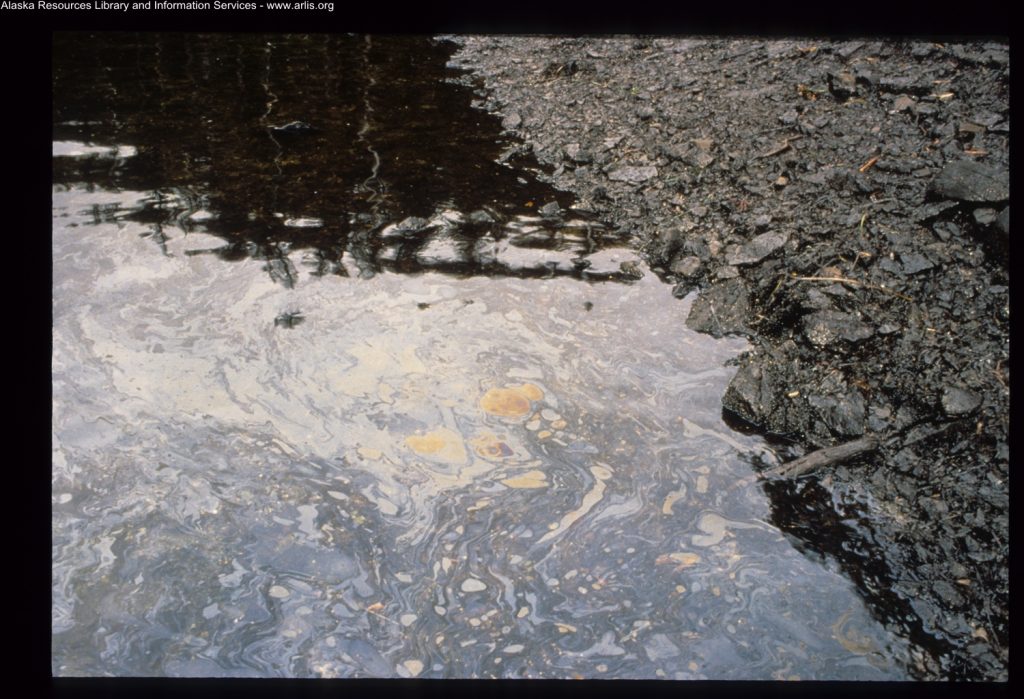 Note. From ARLIS Reference, 2010. CC BY-SA 2.0.
Note. From ARLIS Reference, 2010. CC BY-SA 2.0.
Learn more about oil spills in Rafferty’s article describing nine of the most significant oil spills in recent history.
The COVID-19 pandemic has had a significant impact on logistics both locally and globally. Public health rules and restrictions, people getting sick, closed facilities, health care challenges, and capacity restrictions are some reasons for inventory shortages and delays in logistics networks. These events force supply chain and logistics staff to re-think their entire operation and infrastructure for logistics and facility locations.
Due to labour shortages, reduced operations at factories overseas due to COVID-19, and increased online ordering, there are delays at California’s shipping ports (CNN, n.d.).
Sudden drops in orders, lack of money to fund operations, and failed suppliers caused considerable disruptions in supply chains. For example, one of the lessons learned from the market collapse of 2008 has been to have greater visibility to the financial health of all business partners, and a much faster and more accurate picture of where inventory is throughout the supply chain. Another lesson learned was the increased knowledge and management of cash flow and not just focusing on revenues and expenses (Mefford, 2009, pp. 9-10).
Political and government activity such as the Second World War (global event) and unstable security and humanitarian issues in regions create huge impacts on supply chains and logistics. Shipments can suddenly be stopped. Ships, vehicles and cargo may be seized, held, taken or redirected. People may be re-directed or reassigned to other tasks. Governments and authorities may be required to stop or alter logistics plans to meet the needs of an urgent crisis. Logistics people and systems need to respond to this by reprioritizing and communicating the changes throughout the supply chain. This ultimately leads to extended shipping times and increased costs to manage the uncertainty that these disruptions caused. You might need to suddenly find new sources or acquire extra inventory to account for supply disruptions.
This paper examines how supply chains have responded to terrorism concerns sparked by the events of September 11, 2001. They investigate three factors: how the concern is defined, how the supply chain can be protected, and how supply chains can build resiliency (Sheffi, Rice, Fleck, & Caniato, 2003).
Energy used by supply chains comes in the form of electricity and heat generated from water flow, fossils fuels, renewable energy, and other sources. This energy is used to provide power for industries and logistics networks in our supply chains. The security of this supply is fragile in places and has a significant effect on supply chains.
“China is grappling with a power crunch that threatens to curb economic growth and worsen product shortages that have roiled global supply chains in recent months. Surging coal and gas prices, as well as rising demand for electricity amid a boom in manufacturing and exports, have led to severe power shortages across China, with more than half of all provinces reporting problems. The shortages have resulted in rolling blackouts in some areas, and factories have been forced to close or suspend operations during certain hours to conserve power.” (Griffiths, 2021, paras. 1-3).
A famous example of an accident in a major shipping route is the 2021 Suez Canal blockage. In March 2021, Evergreen Marine’s large container ship, the Ever Given, ran aground due to high side winds. This 400-metre long ship blocked the canal for six days. The impact was felt around the globe, and the projected costs were astronomical. Russon (2021) stated that “… the blockage could cost global trade between $6bn to $10bn a week and reduce annual trade growth by 0.2 to 0.4 percentage points” (para. 21). The 6-day shut down and two to three weeks to clear the backlog was exacerbated by the impact on logistics caused by the COVID-19 pandemic.
Figure 9.8
Suez Canal Blockage
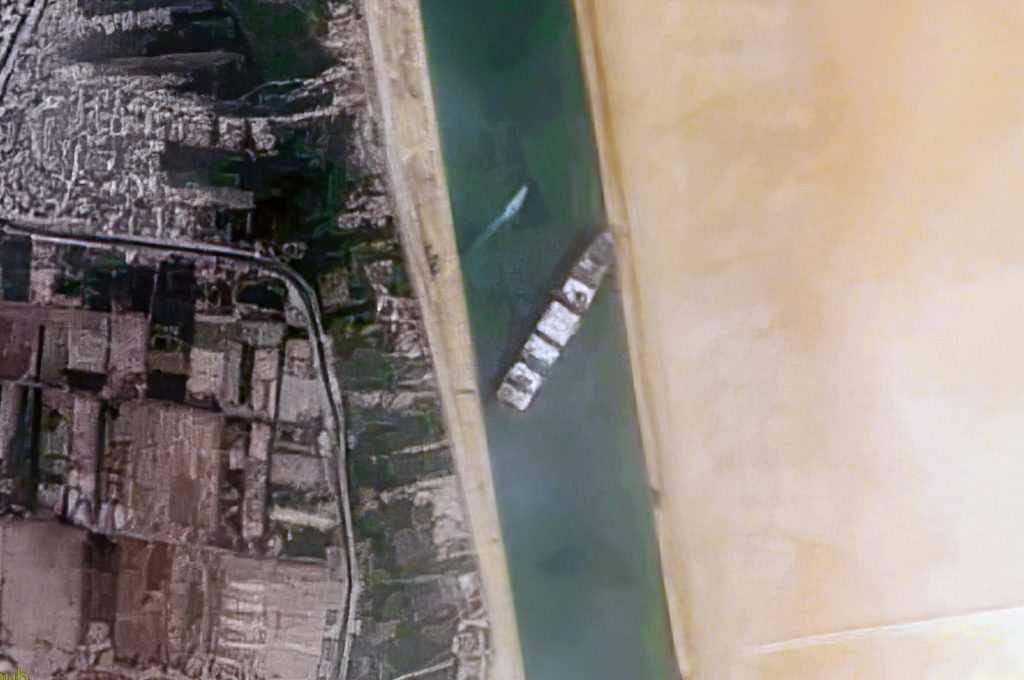 Note. From Markuse, 2021. CC BY 2.0.
Note. From Markuse, 2021. CC BY 2.0.
This image shows an alternate route around Africa instead of going through the Suez Canal which would have added approximately nine days to the ship’s journey (Russon, 2021).
Forklifts are a common machine used in warehouses to move materials and products and they pose potential risks to the supply chain due to injury to workers and damage to equipment. In February 2010, the Ministry of Labour conducted many workplace visits to determine the types of hazards connected to operating lifting devices that included forklifts (Ministry of Labour, Training and Skills Development, 2010). Forklift inspection and training became a priority after a report in the mid-1990s identified that 143 people were involved in power-lift incidents resulting in 136 critical injuries and 18 deaths in workplaces in Ontario (Ministry of Labour, Training and Skills Development, 1999). While there have been increased training and safety measurements put in place since then, forklift incidents remain a safety priority and can disrupt the flow of the supply chain. For example, in 2017 a temporary worker was injured when they stood on the forklift forks and the company was fined as neither the operator nor the injured worker had completed the required safety and forklift operating training (Canadian Manufacturing.com, 2017).
Consider the following steps when planning for the mitigation of risks and challenges to the supply chain:
An interactive H5P element has been excluded from this version of the text. You can view it online here:
https://ecampusontario.pressbooks.pub/logistics001oerfc/?p=68#h5p-19
This chapter on risk just scratches the surface of the subject. Those working in logistics and supply chains must continually identify risks and challenges and assess their impacts on the supply chain. In this chapter, we have identified risks and current challenges, explored potential risks and future challenges, and discussed risk management strategies to better understand major risks and challenges in a supply chain.
ARLIS Reference. (2010). Exxon Valdez Oil Spill. [Photograph]. Flickr. https://www.flickr.com/photos/arlis-reference/4877037643. Licensed for reuse under CC BY-SA 2.0.
CNN. (n.d.). ‘More ships than parking spots’: What a stuck supply chain looks like [Video]. CNN New Day. https://www.cnn.com/videos/business/2021/10/06/shipping-backup-supply-line-california-ports-lah-newday-vpx.cnn
Eavies, P., & Boudette, N. E. (2021, February 17). Winter storm disrupts wide swath of American business. The New York Times, B1. https://www.nytimes.com/2021/02/16/business/winter-storm-business-disruptions.htm
Griffiths, J. (2021, September 30). Energy crisis, rolling blackouts in China could disrupt global supply chain. The Globe and Mail. https://www.theglobeandmail.com/world/article-energy-crisis-rolling-blackouts-in-china-could-disrupt-global-supply/
History.com Editors. (2021, March 23). Exxon Valdez oil spill. History. https://www.history.com/topics/1980s/exxon-valdez-oil-spill
International Finance Corporation. (2020, June). The impact of COVID-19 on logistics [PDF File]. International Finance Corporation World Bank Group. https://www.ifc.org/wps/wcm/connect/2d6ec419-41df-46c9-8b7b-96384cd36ab3/IFC-Covid19-Logistics-final_web.pdf?MOD=AJPERES&CVID=naqOED5
Juha, J. (2021, February 23) High-value truck hijackings expose Canada’s major freight thefts. Windsor Star. https://windsorstar.com/news/local-news/high-value-truck-hijackings-expose-canadas-major-freight-thefts
Kaplan, D.A. (2021, June 1). More frequent, severe wildfires threaten California’s growing logistics network. Supply Chain Dive. https://www.supplychaindive.com/news/weather-climate-california-wildfire-logistics/600620/
Markuse. (2021). Container Ship ‘Ever Given’ stuck in the Suez Canal, Egypt. [Photograph]. Wikimedia Commons. https://commons.wikimedia.org/wiki/File:Container_Ship_%27Ever_Given%27_stuck_in_the_Suez_Canal,_Egypt_-_March_24th,_2021_cropped.jpg. Licensed for reuse under CC BY 2.0.
Mefford, R.N. (2009). The financial crisis and global supply chains. AIB Insights, 9(3), pp. 8-11. https://repository.usfca.edu/cgi/viewcontent.cgi?article=1010&context=fe
Ministry of Labour, Training and Skills Development. (2009, June). Introduction: Guidelines for safe operation of powered lift trucks. Government of Ontario. https://www.labour.gov.on.ca/english/hs/pubs/lifttrucks/gl_lift_1.php
Ministry of Labour, Traning and Skills Development, (2011, January). Forklift and lifting devices safety in industrial workplaces. Government of Ontario. https://www.labour.gov.on.ca/english/hs/sawo/pubs/fs_forklift.php.
Oregon Department of Transportation. (2004, November 1). Truck stuck in the snow [Photograph]. Flickr. https://www.flickr.com/photos/oregondot/2929723050. Licensed for reuse under CC BY 2.0.
Rafferty, J. P. (n.d.). 9 of the Biggest Oil Spills in History. Encyclopedia Britannica. https://www.britannica.com/list/9-of-the-biggest-oil-spills-in-history
Ray_explores [username]. (2015, April 25). A picture demonstrating drought conditions in California at Lake Oroville [Photograph]. Wikimedia Commons. https://commons.wikimedia.org/wiki/File:California_Lake_Oroville_Drought.jpg. Licensed for reuse under CC BY 2.0.
Russon, M. (2021, March 29). The cost of the Suez Canal blockage. BBC News. https://www.bbc.com/news/business-56559073?piano-modal
Sheffi, Y., Rice, J.B., Fleck, J.M., & Caniato, F. (2003, June 1). Supply chain response to global terrorism: A situational scan. Massachusetts Institute of Technology. https://www.google.com/url?sa=t&rct=j&q=&esrc=s&source=web&cd=&cad=rja&uact=8&ved=2ahUKEwiKu9je4az0AhWIB50JHf6uDrUQFnoECAoQAQ&url=http%3A%2F%2Fweb.mit.edu%2Fscresponse%2Frepository%2Feuroma_paper_041603.doc&usg=AOvVaw0lftGJpKSuTUS9xSuzH5Px
Simpson. (2019). Godzilla playing with trains in Godzilla 1985. [Photograph]. Flickr. https://www.flickr.com/photos/gameraboy/46934809965. Licensed for reuse under CC BY-NC 2.0.
Smart, A. (2021, December 2). Floods, heat in B.C. in line with climate change: meteorologist. Occupational Health and Safety. https://www.ohscanada.com/features/floods-heat-in-b-c-in-line-with-climate-change-meteorologist/
Spencer. (2008). Wildfire. [Photograph]. Flickr. https://www.flickr.com/photos/vek/2614279756/in/photolist-4Z1ShU-4Z1ShG-vDUxN-2GcGSd-2mhArt8-2m8KwAv-5fWJs-2jZbfJT-58oCv7-KahwW-2GcGqq-2hoHxeR-XR8x2w-8irsUR-AiwDPN-6awfMT-amsBzR-XdPRYK-gygbp-gyfGt-2mtKkGY-6UdzWX-gygij-YayVa7-LGsYy-gyfwX-LGAZz-Yc7aPL-gyfTz-LGASp-XR8vnj-j7QuA-o6B8YF-a8hTFq-bob3u-8CpsUe-ehucBv-XdPWog-owRT1d-4SgRgi-gvT27-XdPTuR-gvSV4-XtSc5P-4QRLW5-82mmYh-2jJgx7k-uFhv9K-2iPC3js-2kmJsos. Licensed for reuse under CC BY-NC 2.0.
Swire. (2017). Truck crash at Howard Street and Fillmore Avenue. [Photograph]. Flickr. https://www.flickr.com/photos/18378305@N00/41170543841. Licensed for reuse under CC BY-NC 2.0.